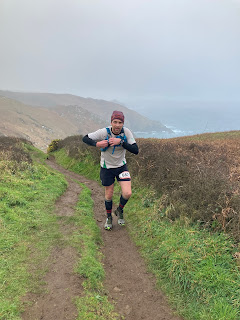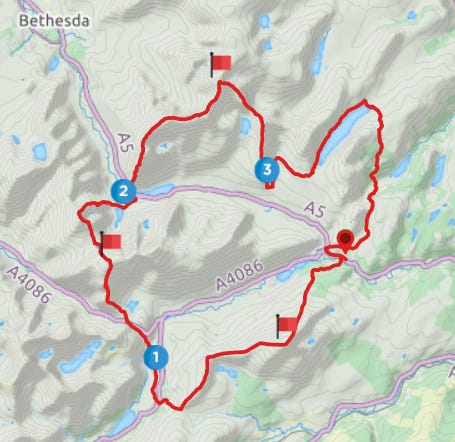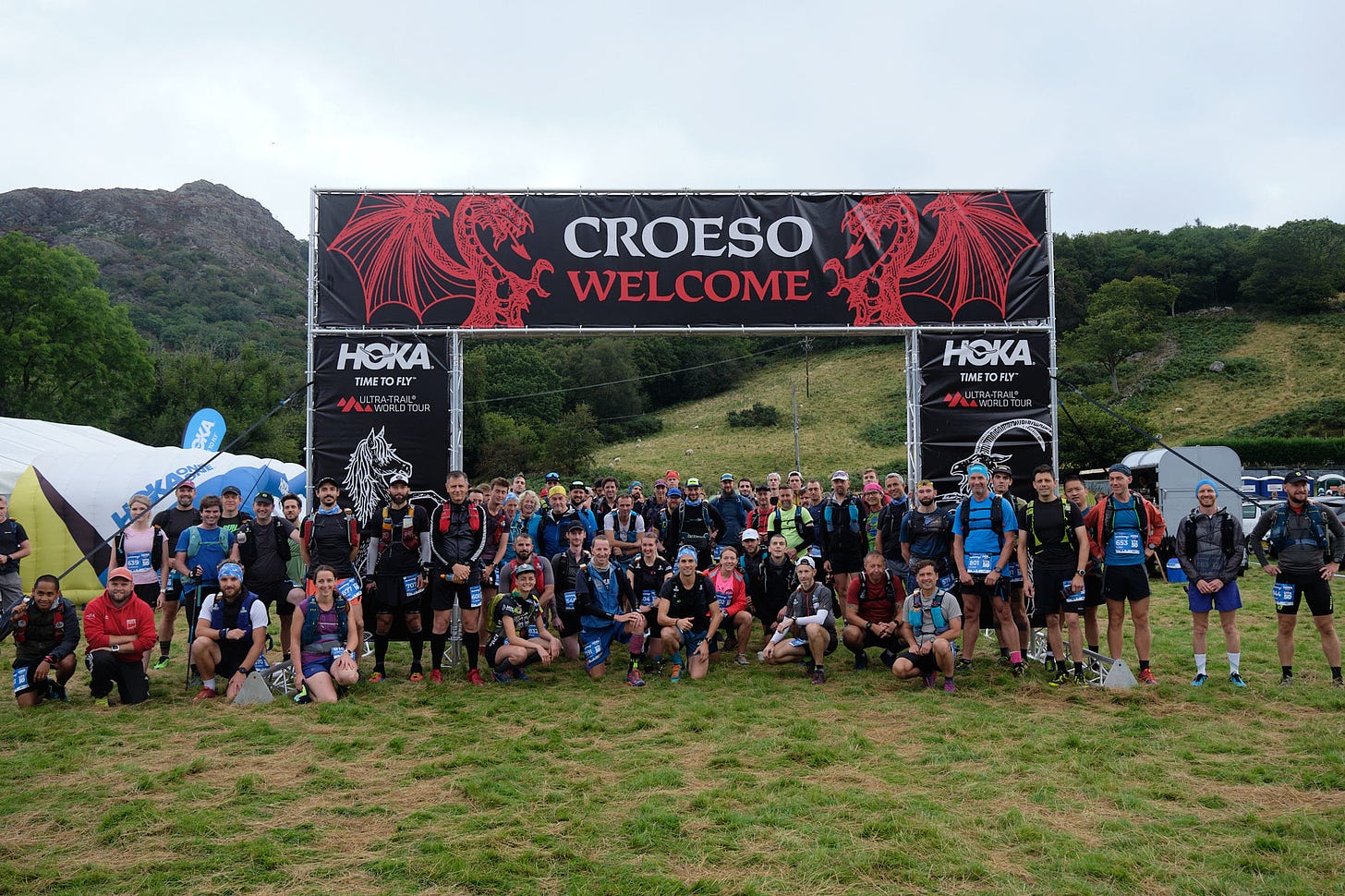Written by Anthony Stevens - https://www.oldiesultras.com/
2022 Silva Northern Traverse: 2-4 April 2022
There is something special about Coast-to-Coast races. Something about the fact that when you finish you physically cannot go any further without running into the sea.
Written by Harry Adair
This is just a short(ish) report for those who were perhaps tracking or following my progress and wondering why I was so slow and why I gave up with only 32 miles left to go.
Some background info. I was running this race with Ben Hall, one of my running chums from the Marathon des Sables in 2015. We had both tried to do this race in 2016 along with Gavin Fletcher, another MDS chum, but Ben pulled out half way between Shap and Kirkby Stephens and I gave up at Kirkby Stephens, Gavin made it to the end.
Written by - Antonio Codina
The why
I just love running winter ultras in the UK, which is strange because I am Spanish and in theory I am more adapted to milder climate. How the hell did I end up embracing being out for hours in the cold, wet and darkness of the UK winters? I have lived in the north east of England for a number of years and I love it here, but I can tell you that the first two years I found the winters very long and dark. I am sure I was even suffering from SAD. Slowly I started to make friends and know the area better and I started to do a lot of hiking and climbing in winter. I discovered that the best antidote for winter blues was to get out in the elements regardless of the weather. Believe me, when you come back home after a winter day in the hills you are glad to be indoors. Yes, that is right, instead of being sick of being at home you are glad to be in the house! I also find that there is something satisfying about being out there when the weather is shit while most of the people are indoors.
Written by - Colin Bathe
February 1st/2nd 2019 - Cornwall
At school I was always the second to last person to get picked for a team in games. This was because I was rubbish. Games wasn’t something I hated like some people, it was just that I wasn’t very good at it. I would like to think I did better at the cross country running but I think this was mainly due to the kids who were bunking off in the middle of the course coming in behind me.
Written by Jean Baptiste Rouvelin - https://jbrouvelin.blogspot.com/
Another weekend down in Cornwall to be part of the run fest Mudcrew organise every January.
This time it was for the 50 miler, so the start was on the Saturday morning from the Minack theatre all the way to Porthtowan using the south west coast path.
The day started pretty early, I decided to leave on Saturday morning from home instead of staying the night close by. So 2.45am alarm time and with my wife Laura for crew, we were on our way to the Eco park in Porthtowan where the finish and registration was.
Nice to see a few familiar faces and getting my race number.
I love the bus journey because I put my head down and just sleep for a bit. I think I managed nearly 30min and that felt great after the early start.
Minack Theatre
We arrived in Minack theatre low car park and walked up the hill to the theatre. I met Laura there who decided to come to the start and cheer me on.
The wind was blowing but the weather was cloudy but dry, not as cold as I ever experiment it before.
We made our way to the Minack theatre and met Charlie Ramsdale. She is part of the Mudcrew Ultra team as is Laura so the chit chat was flowing and I have to be honest I wasn’t feeling the fact I was going to run 50 miles.
We went inside and I left Laura, the start is right down the middle of the theatre. Amazing view and caught up with Joanna Turner. Nice to be with a familiar face and just relax before the race start.
At 8.30am the blue flares were lit, the horn buzzed, the music was going (Led Zeppelin) and Stephen Cousins was sending us on our way. It is congestion time a bit and I used a side alley because I didn’t want to be stuck too much in the back of the pack. I had no idea where I would come if I finish but the idea to not be able to pass and get bottle neck on the coast path didn’t fill me with joy.
I decided to start at a pace I would keep for a long time, so not crazy fast and effort at 5/6 ish I would say.
So we all get out of the theatre, ran across the car park, pass a small gate and straight onto the coast path. Rocky, muddy up and down. Be ready for a lots of miles like that. I do like this sort of terrain I have to admit.
Land's End
The first few miles went pretty quickly and in the distance appeared the Land’s End Hotel, I decided to not have my wife there but instead in Sennen, a mile + down the road. Easier access and cheaper car park also. I didn’t need anything, just the moral booster and removed my waterproof jacket. It was warmer than I expected.
Off I went with only seconds spend with Laura. I was still running with few people at that time and we all made our way to Cape Cornwall. The coast path become at some point from here a bit more scrambling with big boulders to go up and down from.
Happy life for the dogs crewing with Laura
Cape Cornwall, arrived pretty quickly, 11 miles in the race, I ran with an other runner for a bit(sorry I don’t know your name) and we discussed race goal, experience and the rest. I think it is the first time I admitted I would love to run sub 11hr on the course. Felt pretty good at that point. Laura was in the car park. Filled bottle (Tailwind and water) ,fuelled (Rice pudding and coke) and was on my way.
Pendeen light house was only five miles away and came quite quickly. Laura was parked in the tiny car park. Quick food top up and I was on my way. Now was the crappier section from the race. 13 long technical miles. I know that section pretty well by running it when I ran the 100 a few years ago and the recce. I attacked it harder on fresher legs and had a blast to be honest. Met my Mrs at the half way point next to Zennor and I was absolutely loving my time on the trail. The weather was really kind, cracking views and lush trail with my fairly strong legs at the time.
Lots of people was there waiting for their runner, top up water and tailwind (ran out of fluids at the time..) eat some custard and drank some coke and crack on towards St Ives 6 miles away.
Zennor
The journey to St Ives after Zennor doesn’t improve really. Still hard going and pretty up down. You pass headlands and go back inland a few time and pray the next headland will revel St Ives.
Laura was in the first car park arriving into St Ives. I decided to change shoes (giving up grip for comfort) T-shirt, buff. Refuel as much as I could even if food and especially gels started to not go down so well. 30 miles done and now the trail was using a fair bit of road passing Hayle and all the way to the dunes of doom. I didn’t stop to the only checkpoint of the race which was in the middle of St Ives. Just had to put my head through the doors and say Hi. I have bad memories of this checkpoint on the 100. I nearly pass out for the two years I ran the 100 and had to look at the ceiling for nearly 45 min each time. Glad to just be in and out this time.
St Ives
Hit the road/trail out of St Ives and I had a one of my recurring problem starting… “cramping” argh. A bit annoyed with it because I look after my salt and electrolyte intake but clearly wasn’t enough. I find myself lying on the floor on the trail with a man walking by asking me if I was okay. My right inner quad muscle didn’t like the steps anymore and I knew too well how many up and down with tall steps were coming. A runner passed me and gave me a tip to stretch that muscle and told me he had exactly the same problem. I managed to move again and he left me for dead… not great to be pass so easily at a later stage of the race but he clearly felt great and I wondered if I had gone too hard from the start. Doubt entered my mind a bit but the easier running made the few miles going to Hayle tic by nicely. The 100 mile race start on the Friday at midday while the 50 start at 8.30 the next morning, so just before St Ives I started to caught some 100 miler competitors. Some were struggling but everyone I met were still moving forward.
Hayle beach car park, not too happy
Arrived in Hayle beach car park and met Laura. Heart rate was high and felt I was working hard and was generally struggling in the same time. Food was starting to not go in, really well. Had a proper moan to Laura, some food and grabbed my poles to helped my tired legs. The dunes of doom aren’t that bad to be honest. Soft under foot and all runnable. Ran with a few people including the first two ladies. I felt I was the weakest runner of the group I ran with. My legs, head and stomach weren’t playing ball and the next crew point couldn’t arrive quick enough. It was 5 or so miles before arriving into Godrevy car park.
Godrevy
I met Laura in the car park and it was buzzing of spectators and crews. Topped up water and tailwind and decided it was time for some music to help me out. I was starting to properly flag and any help was a must. Got out my head-torch also. Light was fading quickly.
I left the car park and realised the mist was coming down and temperatures were dropping, so I stopped and put my waterproof jacket. Felt a bit unorganised because I could see all the people I ran with in the dune disappearing in the distance.
The north cliff trail were fairly dry and really runnable. Unfortunately my stomach was letting me down and I started to slow and felt really sick.
I meant Laura after a couple of miles and she gave me some coke to try to top up my energy levels. After 300m everything came back out… in some way I felt a bit better. At that point I barely ate anything until the end.
This section is a bit of a blur all the way to Portreath. I only remember the two big up and down with the high steps. The Portreath lights was a nice sight and going through the town was my priority and pushing to the finish. Laura was there and I only waved and told her I would see her at the finish.
The last section to Porthtowan is brutal, it has an other sections with two big up and down and big steps, maybe the last thing you need at that point. The path becomes hard under foot all the way to Porthtowan. Coming down the road into the village felt great and at that point you have an escort or marshals who push you to the next marshall standing at a road junction or the last massive (WTF) hill to climb back to the Eco park and the finish.
Crossing the finish line felt amazing. It is one of my best race for the last two years, my legs felt solid for most of the race and I managed to run solid. My food intake worked alright for 40 plus miles and the salt and electrolytes intake nearly left me cramp free, nearly still have to work on that cramps issues. I managed to go round in 10hours and 31 min which was my target, so well happy of the final results. When I finally stopped and sat down in the finish section of the Eco park, I started to not feel that great and then decided to lie on the ground to stop me passing out. Not hours on end but an easy 15 min to recover from the effort I pushed my body to. The lack of food for the last 10 or so miles showed at that point.
Finished and feeling queasy
All in all, the Arc 50 is a lush race. Lots to see, the scenery is breath taking, the organisation is fault less with great support all the way even if you haven’t got a crew. I would recommend it to anyone who worry to go for the 100 and the event coverage is amazing with Facebook feed and live coverage.
Finished and clearly happy
Laura and I having a quick chat on the live feed before driving back home
Written by Adrian Busolini - https://www.thetrailexplorer.co.uk/
Over the years, I’d heard various rumours about how tough the Arc was. I knew nothing about the race itself though. I had assumed it was exclusive; that one would have to be selected to run it, or enter countless lotteries to obtain a place. So I had chalked up the Arc under a list of legendary races I’d probably never get to run, like the Spine, Hardrock and Badwater, and never bothered to find out what it actually entailed.
Sometime last year, whilst perusing races for 2022 (no doubt shortly after finishing an ultra), I thought to check the Arc’s qualifying conditions. I was surprised to find it only required a 100km finish, and night-time experience. So I looked into entering for 2022; but It was, unsurprisingly, sold out.
I spotted a waiting list button, casually added my name to the list, and then went on to enter some other races, including the Cotswold Way Century. I forgot all about the Arc.
Then, out of the blue, in November, I received an e-mail offering me a place. I had 3 days to accept. I still had absolutely no idea what the Arc actually was, so I finally read the blurb on the website’s homepage. Cornwall, 100 miles, late January, bad weather guaranteed. I had been looking for a January ultra, and wanted one with a bit of an extra challenge, so this seemed perfect. I entered.
After a few weeks, I got around to checking the route. It tracked 100+ miles of the 630 mile South West Coast Path, around the headland of Cornwall. I’d run 70km of this route earlier in the year, in a race called the Classic Quarter. So the section from Lizard Point, through Penzance, to Land’s End, was a known quantity. Coverack to Lizard would be new, as would the long stretch from Land’s End, through St Ives, to Porthtowan.
I should mention that the Classic Quarter, despite being only 70km, was easily one of the toughest races I’d run at the time. This was mainly down to the technicality of the terrain, complemented by a healthy amount of vertical gain, and total exposure to the North Atlantic winds. Unless one had the bravery of an elite fell runner, braking on the precarious downs chewed up one’s quads very early on. Then there was the section from Mousehole through Porthgwarra, whose technicality rarely yielded runnable sections longer than, say, 50 metres. I could at least relax in the knowledge that the rest of the course couldn’t be any tougher than that section – with the exception that I’d be running it in the height of the winter, as opposed to the middle of spring.
In the few weeks out from the Arc, I reflected more on my experience in Classic Quarter, and as a result I purchased more kit than I think I’ve ever purchased for a race. New in was a Montane Gecko VP+ 12l pack, a Montane Minimus Stretch Ultra, a Montane Dragon top, a Patagonia Primaloft fleece, Inov-8 X-Talons, a Fenix HM65R-T headtorch, a 250ml soft flask for concentrated nutrition, and a couple of other pieces of mandatory kit unique to the Arc. I didn’t take all of this hoard with me, but I was starting to appreciate the challenge this race would pose.
I also pulled together a basic race and nutrition plan, but work commitments kept me from devoting as much time to this as I’d have liked. I still had fairly little idea of what to expect of the rest of the course (aside from a few worrisome things I’d read about the Pendeen to St Ives section).
A real concern for me was that there were only 4 aid stations and 1 drop bag on the course. Given these aren’t evenly spaced, the race has a 36 hour cutoff, and I would be uncrewed and thus have to carry everything myself, we’re talking about an awful lot of kit. My pack weighed in at over 5kg, which for a chap weighing only a little over 50kg, is considerable.
There hadn’t been very much rain in the fortnight preceding the race, so the ground conditions were said to be generally favourable. The race day forecast was a balmy 9-11 degrees C, with 5-10% chance of rain, and wind building throughout the day and night. We joked about course PBs on the starting line, whilst Stephen Cousins (of Film My Run fame) livestreamed proceedings and interviewed the race seeds. I noted there were a lot of quite high profile participants on the starting line, and runners I spoke to at random reeled off a pretty impressive list of races they’d conquered. Spine, Spartathlon, WS, Gland Slams, you name it: it was a high quality field.
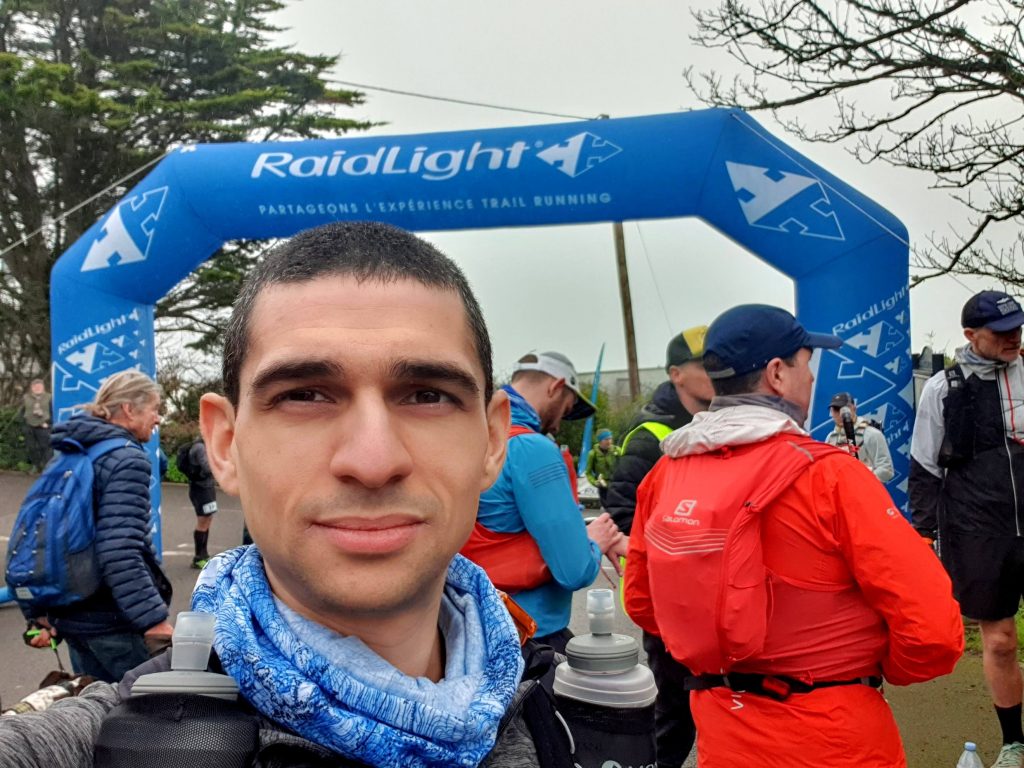
The start of the Arc is an impressive affair; the banging of the drum, and off into clouds of blue smoke. I nestled into around 30th position, roughly where I wanted to be to avoid getting caught in the throng for the early single track climbs, whilst avoiding holding the faster folk up myself. That didn’t really work, but not for the reasons I expected.
The fast pack took a wrong turning after just a few hundred metres into Coverack, and I found myself leading the race (I think) as we entered the trails. It stayed that way for a km or so, until the faster folk managed to forge paths back to the front, and as they did I pulled over to let them overtake one-by-one. As some big names passed me, I reflected that it was a surreal start to the race. Unfortunately, amidst all the excitement, I’d been pushing considerably harder than I ought; the old adage, don’t go out too fast, had not been heeded.
(Note: having listened to the Arctermath episode of the Trail & Error podcast, it sounds like Tristan may have been ahead at the start after all. If I’d have known that at the time, it might have calmed me down somewhat!)
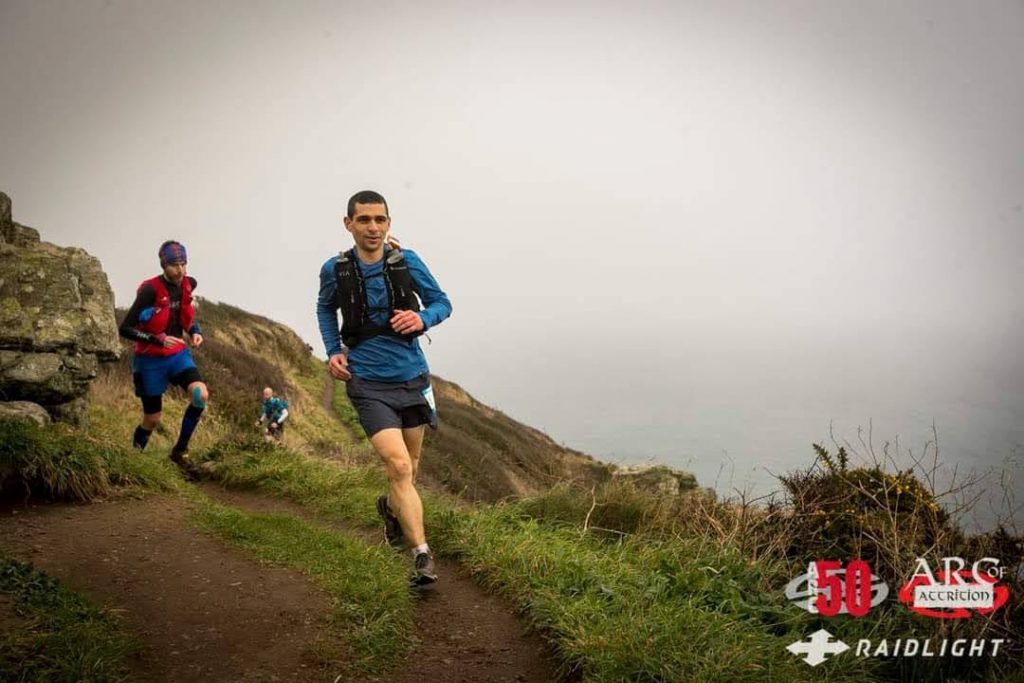
Based on a few things I’d heard, I was expecting the Coverack section to be a bit muddy to start, but otherwise fast trail to Lizard. As I was finding out, it was actually a hilly & technical stretch, just as much as the Lizard-Marazion segment I recalled from the Classic Quarter. It was not the easy start I’d been expecting, especially after my race-leading speed section.
We couldn’t see very far out to sea through the Cornish mizzle. I kept my midlayer on for little while, before removing it and simply running with my Patagonia baselayer. I was too hot with the mid, and too cold with the base. I chose the cold.
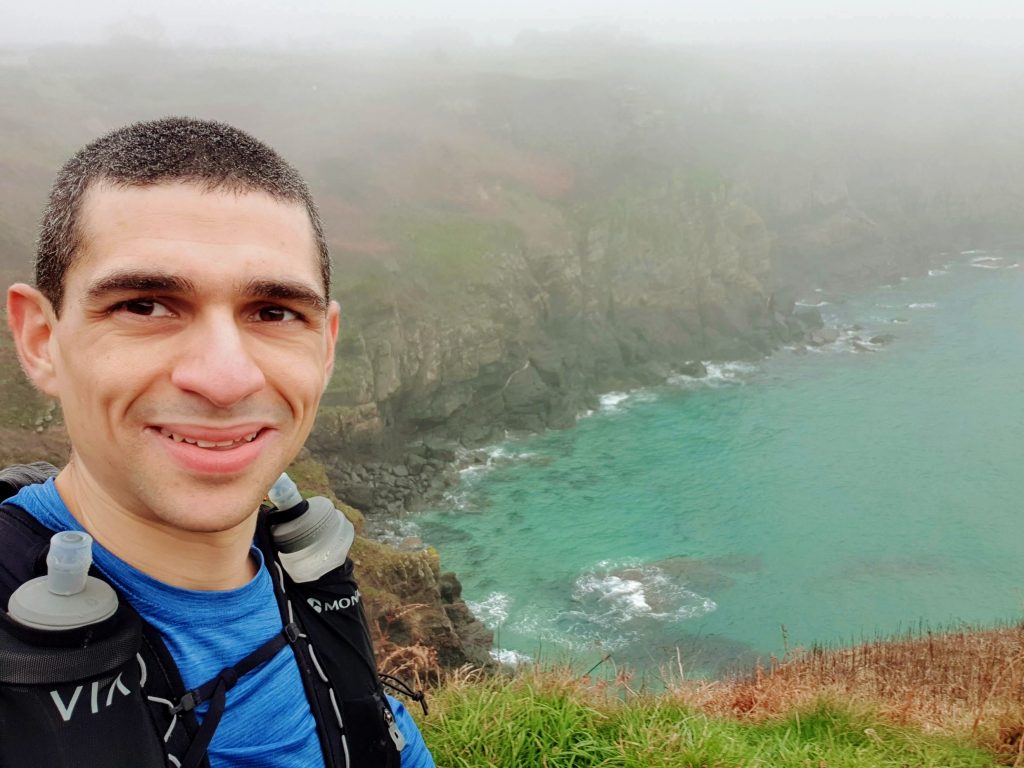
As we reached Lizard Point, I began to recognise sections of trail from the Classic Quarter, and quite enjoyed this little jaunt down memory lane. I reflected that I’d definitely recalled it with rose-tinted spectacles: this section is really technical, much more so than what I’d been training on over winter. I wouldn’t have minded, except I knew that relative to the Mousehole section, this was easy – so I was readying myself for a tough day and night ahead.
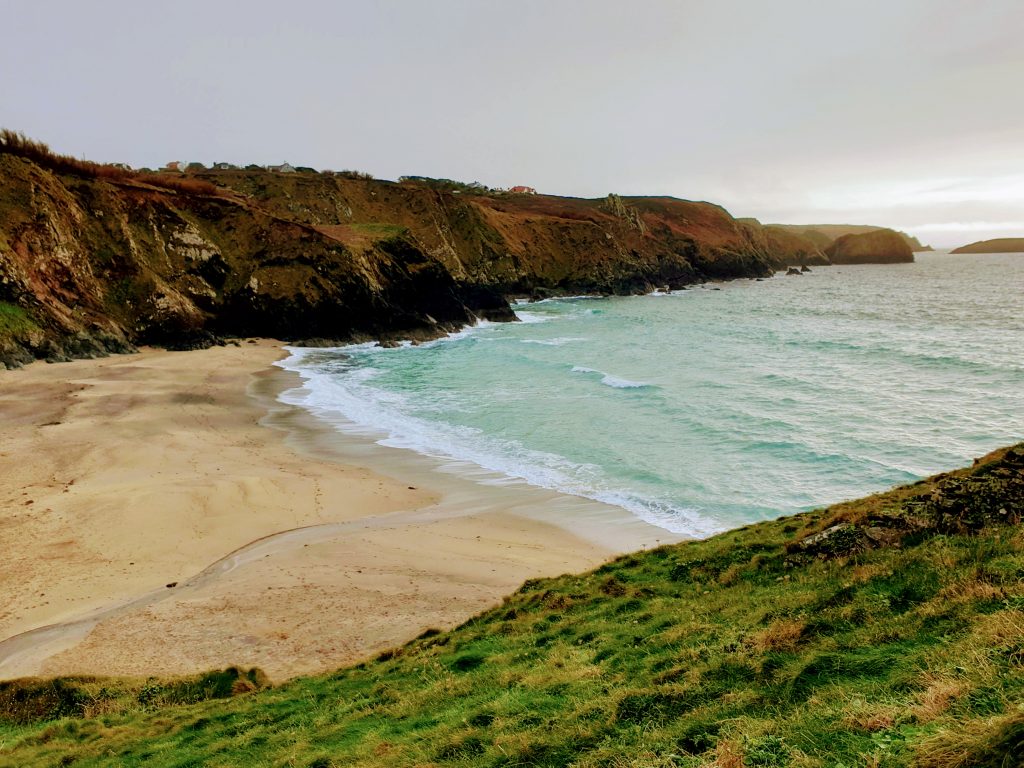
It’s a long winding route in and around all the various coves on the way up to Marazion. In toward land, along, out to the coast; down to the beach, over a stream, up to the cliff; and so on. After what seemed like an eternity, the mist cleared and the distant lights of Penzance came into view over the sea. It’s great to be able to see your goal, but getting there is quite another story!
The quads were, just like in the Classic Quarter, taking quite a hammering on the downs. I was wearing Inov-8 RocLites (I hadn’t managed to find a suitable X-Talon in my size beforehand), and the pair I was wearing for the first half had already seen more than 1500km: the lugs were pretty well worn. Their remaining traction wasn’t really up to the task posed by this slippery trail and its descents. This meant I was having to take more care than usual, and that involves braking – or, in other words, repeatedly jolting one’s entire bodyweight through the quads.
Carrying a 5kg pack was proving quite an experience too: whilst my Montane 12l was doing a brilliant job, there’s simply no way to ignore an extra 10% of your body weight on your back. At least it provided a tangible incentive to drink my water and consume my calories, in an effort to reduce pack weight.
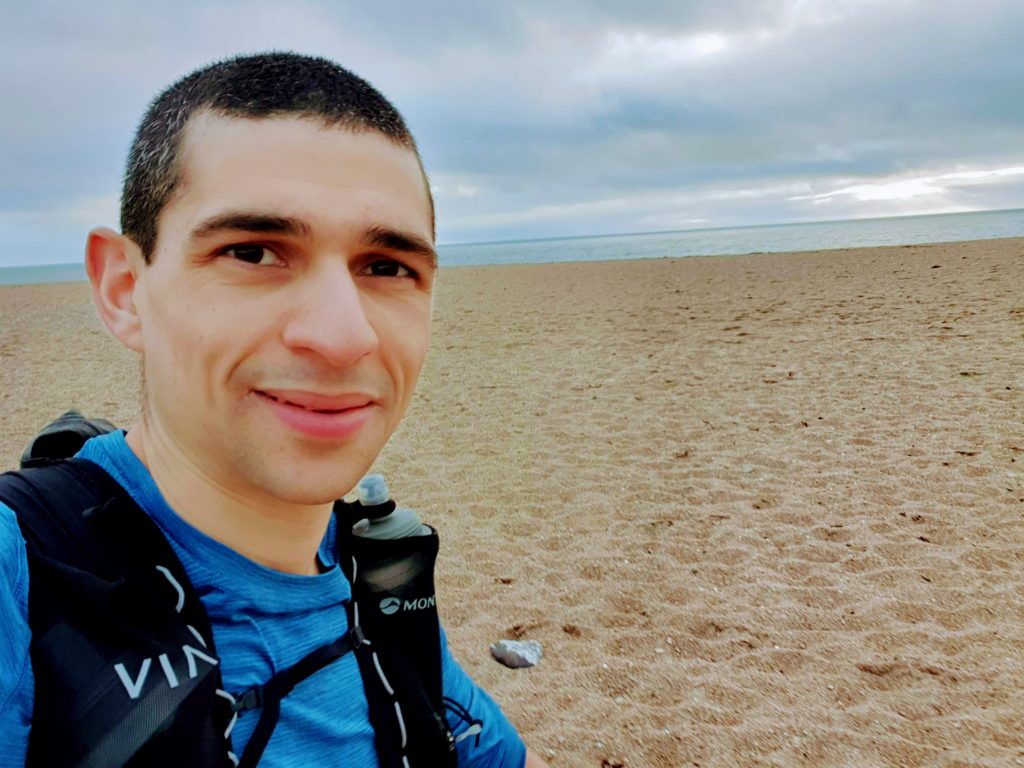
By the time I reached Loe Bar beach, the early exertions had taken their toll, and I was starting to flag. I walked pretty much the whole length of the sandy beach. On the other side, there was a climb up away from the beach, back onto coastal trail, where I got going again.
The sun was gradually setting as I approached Porthleven. The mizzle had cleared, and the wind was still subtle. So much for a winter ultra: this was glorious!
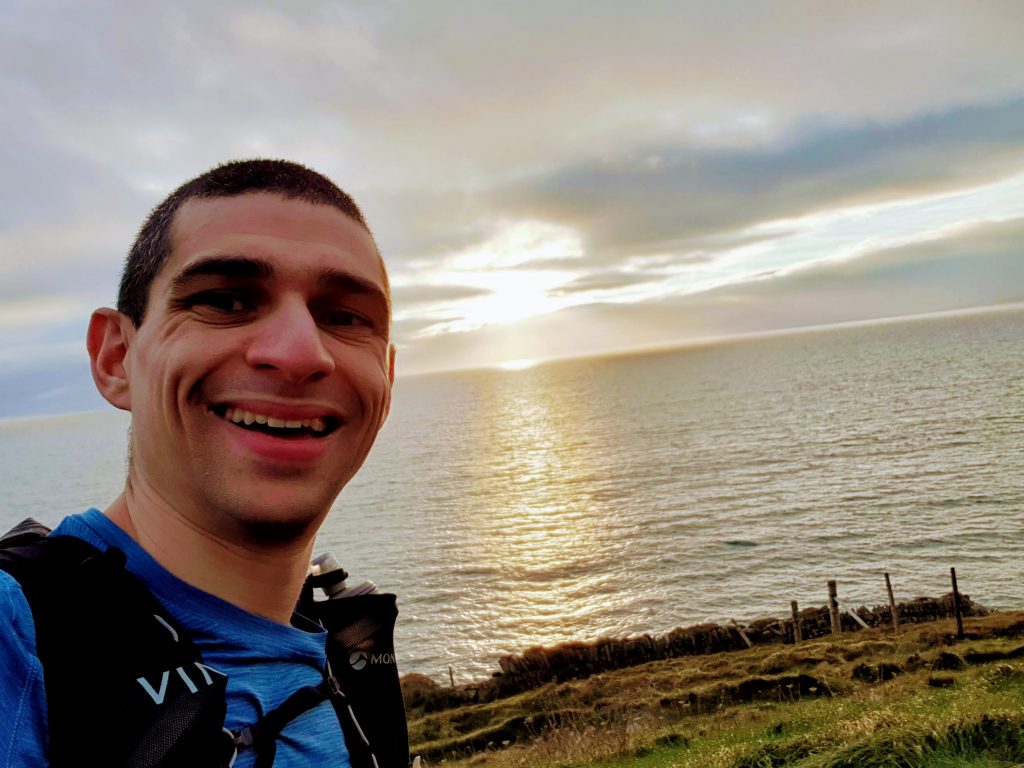
On arrival, I was amazed to find Arc “valets” waiting to run us up to the aid station. A 5-star service indeed. I got some potato and leek soup down, a bit of watermelon, and refilled my bottles. A 5-10 minute turnaround at most. The soup was rejuvenating, and I scooted out of there relatively happy. I’d forgotten to add a Tailwind sachet to one of my water bottles, so paused just beside the sports field, tore a corner off the sachet, and delicately tapped its contents into the bottle. Despite my efforts, half of it went over my hands, my pack and my shoes. I grinned: that would teach me to be better prepared at the next aid station.
I checked the time, and it was excellent – I was way ahead of schedule. Despite a fast start, a heavy pack, and slippery terrain in my overly-well-worn shoes, I was doing OK.
Passing through Perranuthnoe, I recalled some advice I’d received about a common routing error people make at Trenow Cove: stay right on the path, don’t veer left down onto the beach. Surely that was obvious, I pondered, as I absentmindedly forked left and cruised down a lane, headed toward that very beach. Fortunately, I spotted my glaring mistake within 30 seconds. I swung around, mildly embarrassed, and jogged back up the path, explaining my mistake to a confused runner who had followed my lead.

Light was fading, so I donned my Fenix HM65R-T and turned on its 400 lumen spotlight. I prefer the Fenix over the Nao+, which I was also carrying, in the capacity of a backup light.
It wasn’t far to go to Marazion. Whilst I didn’t recall much about that town from the Classic Quarter itself, I had subsequently walked there from my B&B in Penzance, along the beachfront promenade for a green tea in the Godolphin, before hotfooting it back in the pouring rain. A charming historical seaside town, I was looking forward to running its winding high street once more.
As I emerged from the coastal path onto a residential street, I remarked to waiting crews that it felt good to be back in civilisation, and felt my pace quicken with expectation. Marazion was exactly as I remembered it, and I reflected how pleasing it was to be back again so soon. I passed the Godolphin, and ran through the car park alongside the beach, before carving a path through the strip of sand leading to the brand new promenade running along the Marazion-Penzance beachfront. During May last year, it was still under construction, so we’d had to run along the roads instead; this time around, it was a far more pleasant experience. I was quite content plodding along here, ensuring I maintained a healthy pace to make the most of this rare stretch of flat.
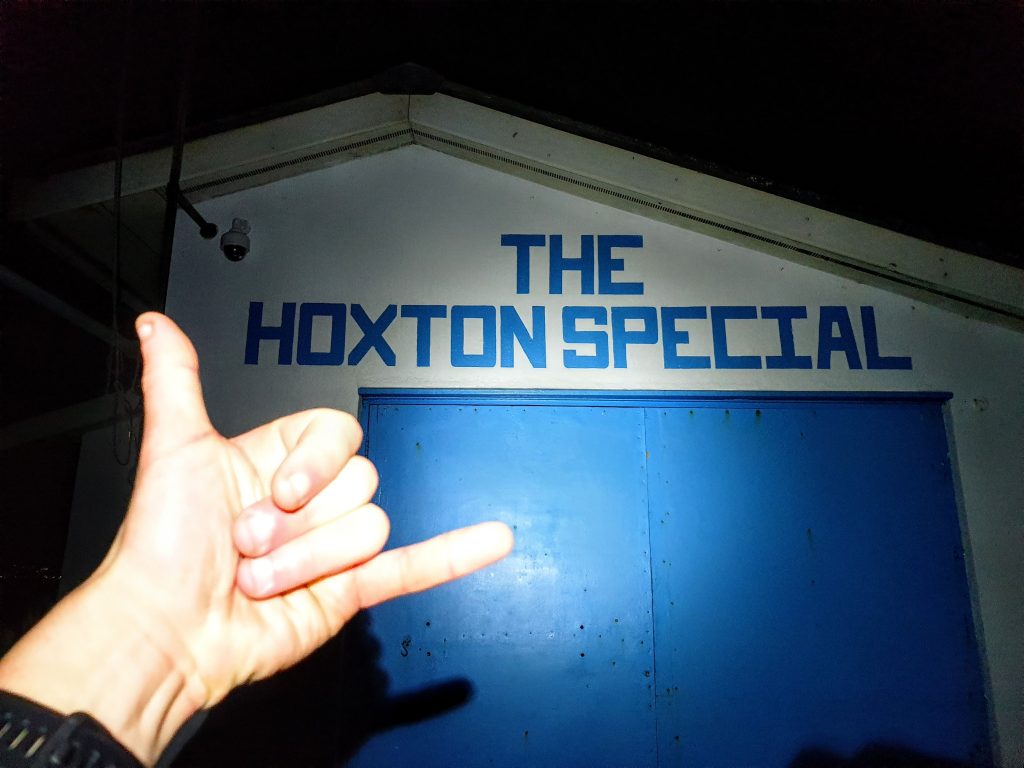
Approaching Penzance, I could see another headtorch up ahead, and quickened my pace to make up ground. My background is more road running than mountain, fell or trail, so I felt as though I should be coasting past people with ease here. I was surprised by their pace – this runner was going some. Not to be outdone, I sped up even more. Eventually, beside the train station, I drew alongside the runner, who – to my surprise – stopped running and stepped to one side, before offering me some words of encouragement. It was just a local, out for their evening run.
I was in good spirits as I threaded myself along the familiar streets of Penzance. The aid station was directly opposite the B&B I’d stayed in previously, so I knew my way; but the Mudcrew valets were there again, ready and waiting to run me from the promenade up to the rugby club. It was nice to have them to chat to after the stretches of solitude.
In the aid station, I downed some carrot & coriander soup, some chips (ultras certainly aren’t health drives), refilled my bottles, and headed straight back out into the night. Another fast turnaround under my belt.
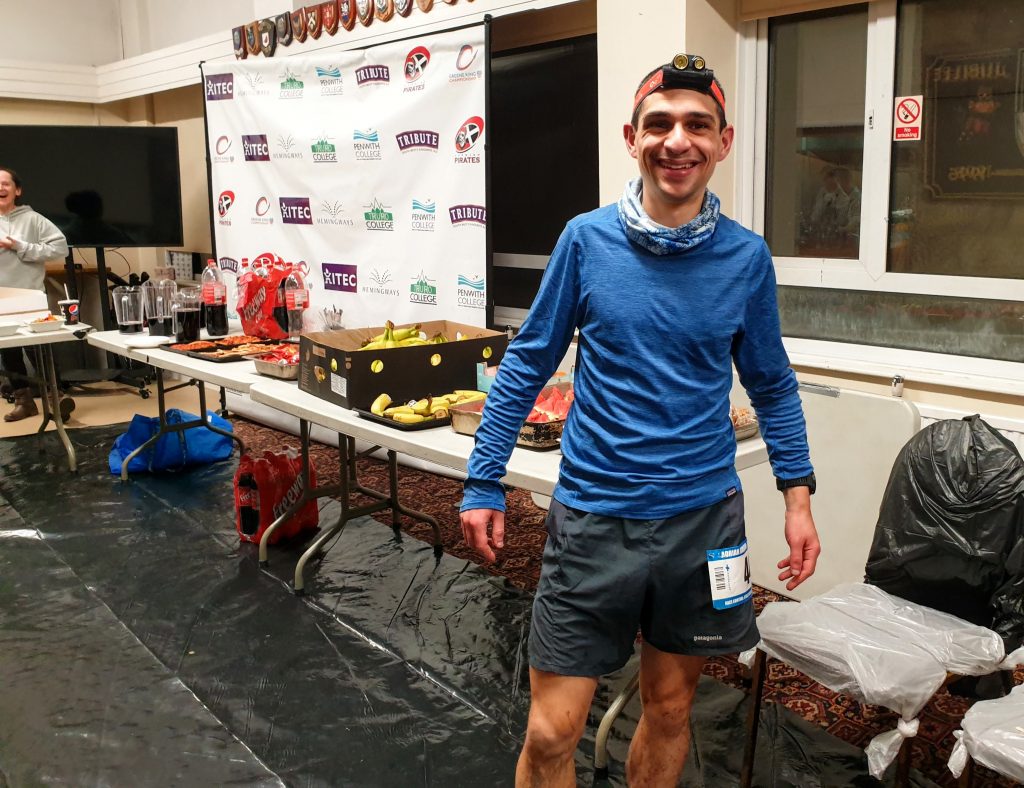
It’s easy running into Newlyn and through to Mousehole, where the coastal path fiddles around the town somewhat before heading steeply up back onto trail. My path crossed a runner who remarked I’d taken the scenic route, and asked me how much extra distance I’d added on. I hadn’t: the route I’d taken was the marked coastal path, and matched the GPX route.
As soon as I hit the trail and switchback, my thoughts switched to the extremely technical section I had to cover to reach Land’s End. In the Classic Quarter, I’d run this stretch during the daytime, and mostly remembered it as a ponderous, slippery technical trail consisting of lots of clambering, linked by short runnable sections measured in just tens of metres.
It was mostly as I recalled. There was some very mild exposure, which I found delightfully atmospheric at night: the vivid sounds of the waves crashing against the shoreline replaced the eyewatering visuals one gets during the day. Those runnable sections were quite special in places. Yet, the technical sections were just as unrelenting as I had recalled, and the downs were pretty treacherous (especially in my heavily worn Roclites). In places the muddy trail was replaced, without warning, by bogs that swallowed one’s entire lower leg. These made the regular stream crossings seem like something of a blessing in comparison.
On the start line of the race, I’d noted that most of the runners were wearing gaiters. It was during this stretch that I really wished I was too, as my shoes were hoovering up debris like a Dyson. I stopped once to remove a large jagged stone, but otherwise tried to ignore it all: I had a change of shoes waiting in my drop bag at Land’s End. So long as my feet survived this section, help was at hand.
Out of nowhere, a spectator emerged and informed me I was approaching Minack Theatre. This excited me: Minack had completely passed me by during the Classic Quarter, and having subsequently seen photos of the nearly 100-year-old open air theatre, I was keen to see it in person.
Of course, it was nighttime, and yet again I didn’t get to see any more than the car park; but this setback didn’t dampen my spirits, as Minack was a solid milestone along the route to Land’s End. Talking of milestones: for some reason, I thought the stretch from Penzance to Land’s End was some 40km, and thus expected to pass the 100km mark well before arriving into the third checkpoint. I was carrying a detailed race plan in my pocket, but the ongoing technicality of the terrain didn’t afford many opportunities to decipher tiny text, so I never checked it. In reality, it was only a 25km stretch, and would finish well before I hit 100km.
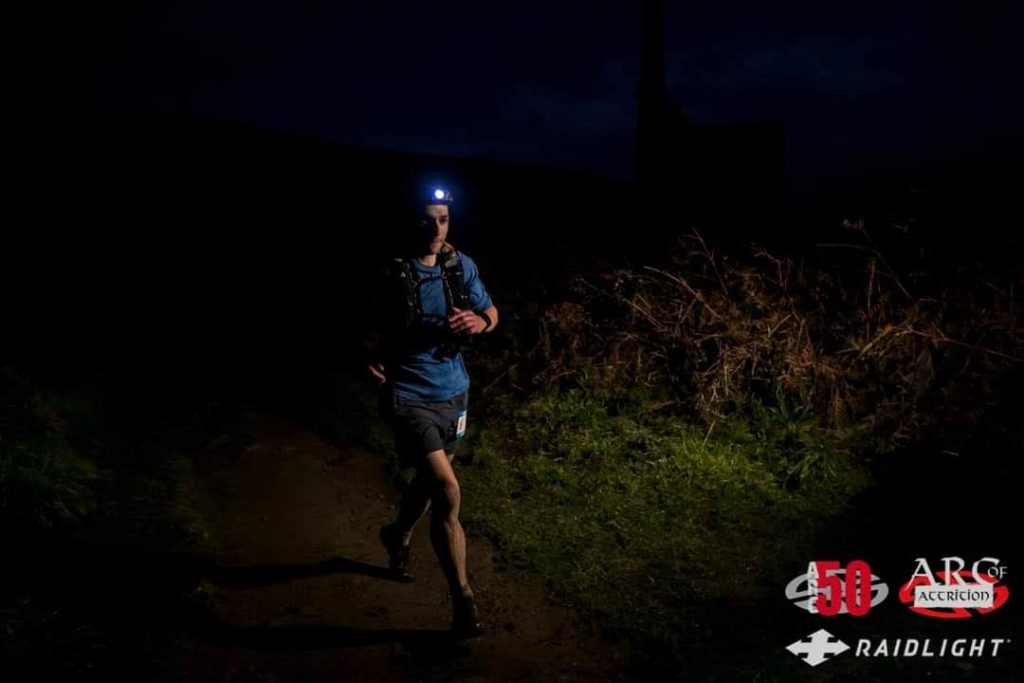
Whilst moving at this slower pace over technical terrain, the mizzle and building wind was proving to be a frustration. It was hard to work out what to wear – whatever you chose, it was a compromise. I also knew I had a different midlayer waiting at Land’s End. Considering my clothing options kept my mind occupied for a while, as I picked over the rocks.
I was tracking the compass on my watch, and became excited as it wrapped around to face north. Land’s End was inching closer. I knew the landscape in this final stretch opened right up, both providing some visual stimulation, and facilitating some longer, free-flowing runnable sections. Then I observed what looked almost like a rising sun flickering into view over the hills. It was the Land’s End Hotel, bedecked with a thousand warm yellow lights, shining like a beacon in the night.
As is often the case in ultras, seeing a target is quite different to reaching it. There was a lot of technical trail running between me and the aid station, on a trail that continually wrapped around the coves; each time, dropping rapidly down to sea level, then climbing straight back up. But that didn’t matter: my gait was flowing, I was feeling pretty good, and Land’s End was in view, where some veggie chilli was waiting.
For the third time, a valet met me some 500m out from the Hotel, ran me up the final ascent and into the aid station. Part of me wanted to run straight past, as I didn’t really want to interrupt my flow; however, there was business to attend to. I grabbed my drop bag and immediately put my watch and phone on charge. I had some 20 minutes or so planned here; time to change my shoes and socks, eat some hot food, and sort out my food supplies for the second half of the route.
Iwolfed down some of the bean chilli, and then a second helping. It was good. I also had some of the tomato soup, and a couple of slices of watermelon. I then turned my attention to my feet. My shoes were completely saturated with mud: not in clumps as I’d been used to dealing with over the winter, but properly, properly saturated with liquid goo. As I removed them, mud, stones, grit and sand flew everywhere. This revealed my brand new white socks, which were now unrecognisable. I peeled these off, which again spewed debris all over the hotel’s floor. I brushed off my feet as best I could, and donned a fresh pair of socks, and another pair of Roclites – fortunately, these had considerably better lugs than my previous pair. I then transferred labelled bags of nutrition to my pack (one bag per aid station, where I rotated it from the back to the front of my pack).
I had trialled a new food source during the first half of the race: a 250ml soft flask filled with c.125g of Tailwind and a little water, to form a sort of Tailwind gel. It hadn’t worked very well: first off, the water and Tailwind separated, requiring me to regularly massage the flask to mix the two. Secondly, it tasted quite sharp and very salty. I didn’t fancy that again for the second half of the race, so I left it behind in my drop bag.
My phone was sufficiently charged by now, but my Garmin 945 was still going. I wanted at least 80% charge, and resolved to wait. I hang around, drumming my fingers, with literally nothing more to do. I absentmindedly grabbed a packet of crisps for the salt, and wolfed them down, before reading the ingredients list to pass the time, and spotted a couple of things I don’t eat: milk and wheat. I hoped it wouldn’t upset my race. After a while, my Garmin showed 82% charge, so I pulled the plug & headed off back into the night. I’d not seen any of the route from here to the finish at Porthtowan, so what followed was guaranteed to be an adventure.
The trails leading out of Land’s End are well defined, but numerous and thus a little confusing. I was pretty cold, having been seated in the warm for a half hour or so, and so I tried to quickly get back to a good pace to warm up. However, this was proving challenging, as a problem was developing in my gut: I was feeling nauseous.
Ihadn’t ever experienced GI distress in a race before. I wasn’t sure what had caused it, and wasn’t too sure how to deal with it. I slowed down to let others pass, trying to maintain a clear path both ahead of and behind me, just in case I needed to upchuck. I stopped eating & drinking for a while, and briefly stopped off-path on a couple of occasions, hoping it would clear. I half-heartedly tried to force the matter a couple of times, without any success. After a while, I gradually started reintroducing food and water, and could sense a return to normality. I would be fine thereafter, and appreciated that nothing had come up: the last thing you want in a race, I reasoned, is to displace vast quantities of food and water, only to have to replace them again.
My temporary GI problem aside, I enjoyed the terrain from Land’s End to Pendeen Watch: it was less technical than much of the preceding trail, and afforded good nighttime views. There were glimpses of the lighthouse, and some fun sections clambering over boulders that reminded me of Snowdonia. I wasn’t tracking exactly where I was, or which crew stops I passed. It didn’t really matter. I was approaching the infamous Pendeen stretch, and I’d know it when I hit it.
I’d just dropped down a descent, the coast wasn’t far to my left, and the trail snaked gradually upwards and along the coastline. After a few strides, the trail was replaced by a pond, dotted with a handful of slippery rocks intended to be used as stepping stones. I successfully rock-hopped for a while, then my heart skipped a beat as my body plummeted straight through the muddy trail. I looked down, and couldn’t see my knees beneath the muddy bog I’d landed in. I reasoned that I had reached Pendeen.
Was the Pendeen-Zennor stretch as bad as people had claimed? I think so, yes. In a colder, wetter year, I can well imagine this stretch being borderline unbearable. It was bad enough as it was. The wind had really picked up by now, just as my pace had plummeted whilst trying to traverse this tricky terrain. My exposed legs were freezing. The mizzle continued.
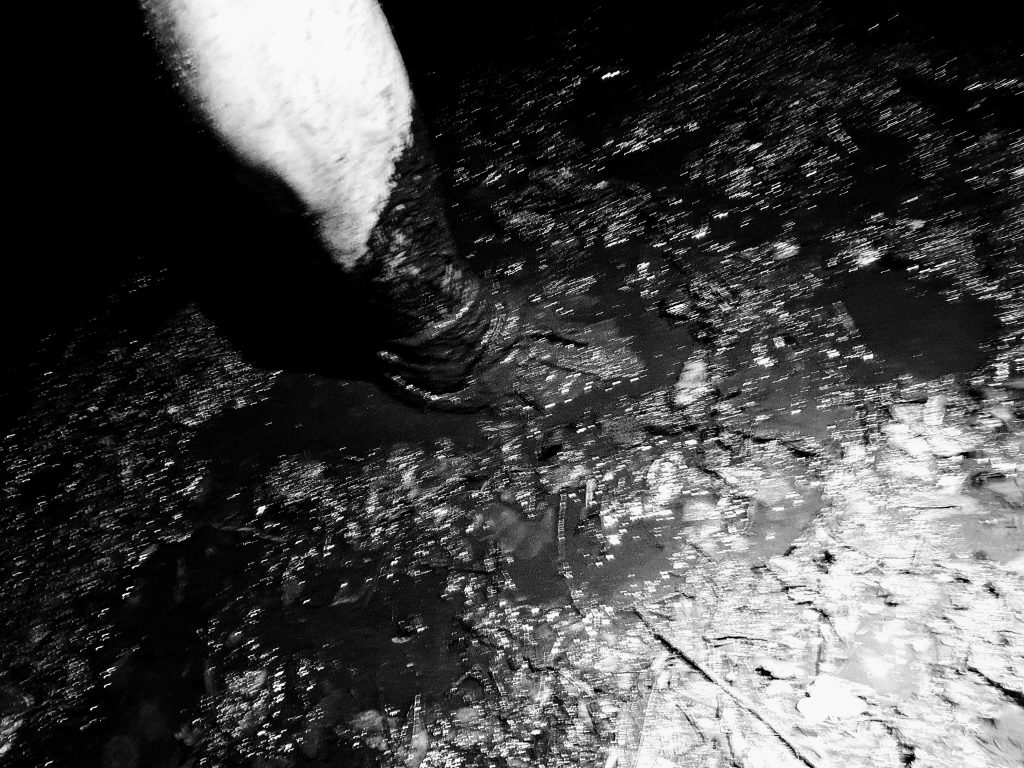
By the light of my headtorch, I slowly trawled through bogs & streams, tentatively picked my way down steep, slippery rocky paths, clambered over boulders, slid down mudslides, scratched past bushes of gorse, slipped over and shivered. I was moving so slowly, because I didn’t want to injure myself out here in the back of beyond. I wanted to finish the bloody race.
Before I’d started, I’d forgotten to disable my Garmin watch’s feature of beeping on every kilometre, and it had been mildly frustrating me ever since – beep, beep, beep. However, through this section, the beeps came so infrequently that I often wondered whether my watch battery had died. I was averaging 15 minute kilometres, slower than walking pace.
For me, the race was defined by this Pendeen – St Ives section, so the slow rate of progress didn’t overly concern me. I knew that with every step, I was breaking the back of this race. I counted down the kilometres remaining to Zennor Head, where I was hoping there’d be some Arc Angels waiting with water supplies. I hadn’t been drinking very much (the terrain was too technical to worry about that), but I intended to stop and down a litre at Zennor, and top up all of my bottles. So when I spotted a chap in a puffa jacket waiting at the top of a climb, I prepared myself to take on supplies. Something salty would be welcome, and I might even consider pulling on some trousers before I tackled the next half of this stretch.
When I reached the gathering of folks at Zennor Head, I immediately realised that my expectations were totally out-of-line with the reality. There was no shelter to stand under. There were no Arc Angels waiting with a van of supplies. As I scanned my eyes around the motley group of 5 cold, tired crew members, I realised how few supplies they had with them. I could see one part-emptied 2l bottle of water, and one more 0.5l bottle. A couple of handfuls of treats. There were obviously no cars nearby. This was it.
I didn’t want to impress my needs upon someone else’s crew, when they were clearly carrying only the bare minimum. If you’re crewing someone else, you don’t want to be put in the position of choosing between a random runner asking for help, and preserving supplies for the runner you’re crewing. So I didn’t even stop – I just ran straight on past, calling out a muted “hi” as I did so, and braving a smile. I immediately transitioned my mind to the next 10km of ugly, treacherous trail. It was time to batten down the hatches, puff out one’s cheeks, and push on to St Ives.
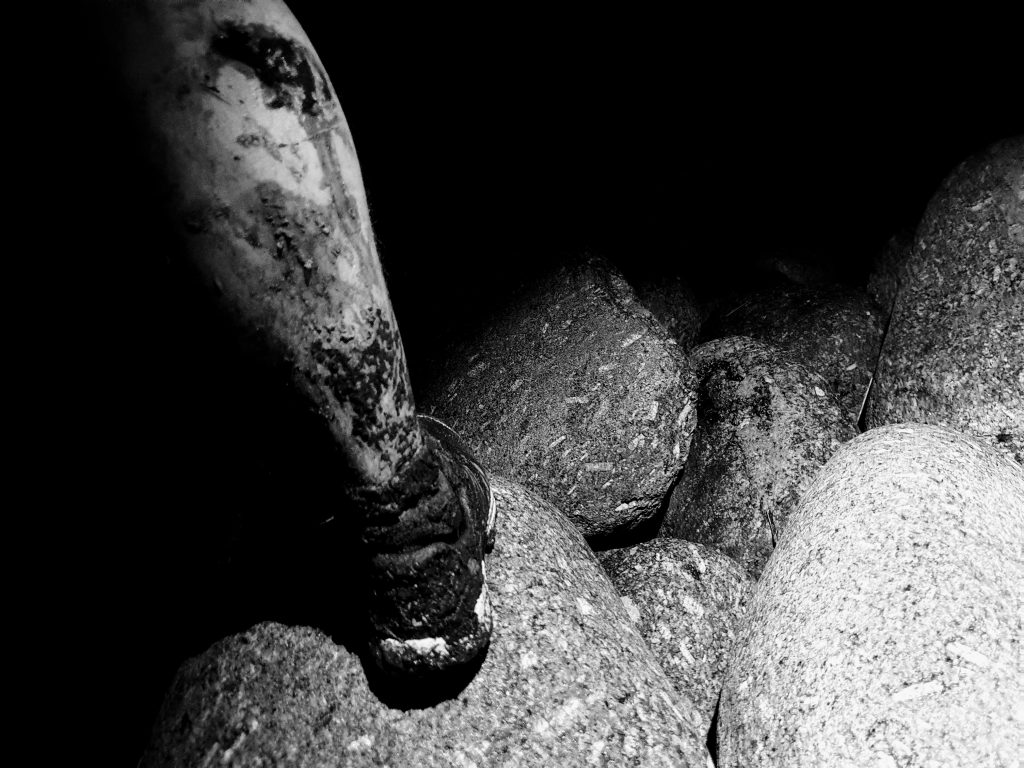
The Zennor-St Ives stretch was much the same as the Pendeen stretch. Probably slightly less boggy, with a few more runnable stretches, but still broadly as technical. As I neared the end of this interminable nightmare, darkness cleared and I could finally remove my headtorch. I was immediately relieved of a headache I hadn’t even realised I had. The terrain began to return to more traditional coastal path: the sharp descent down to sea level, over a bridge, around the cove, and sharply back up to the cliff.
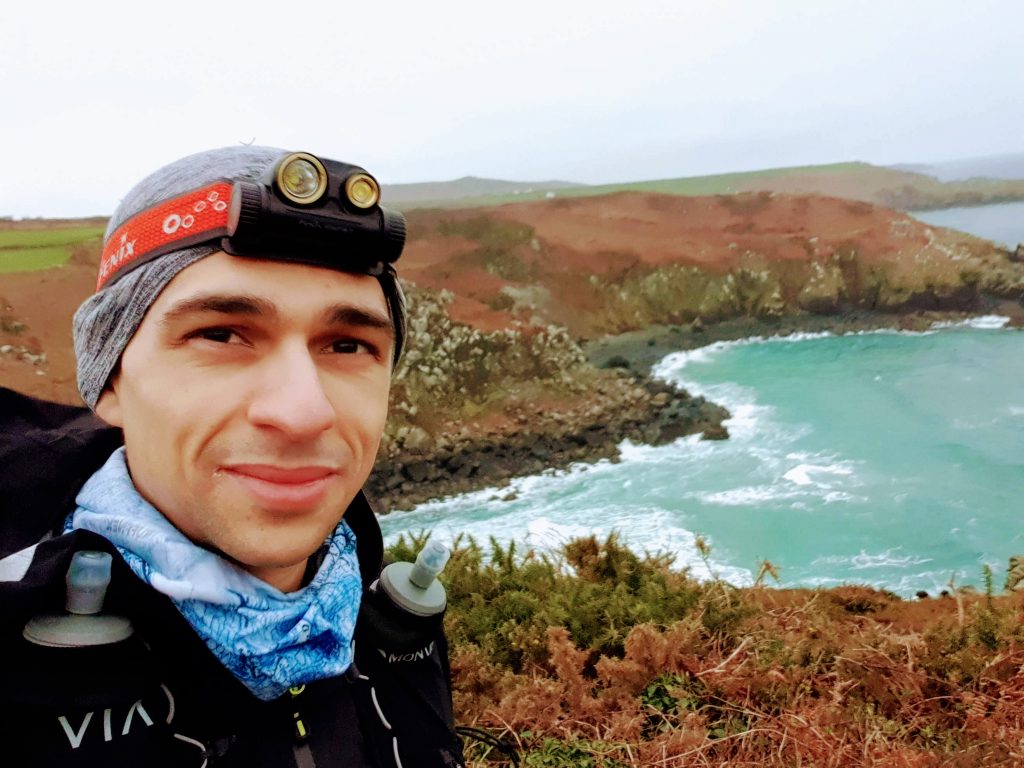
The shoreline was a thing of beauty: the sea’s vivid aquamarine colour lept out at me, in sharp contrast to the dark, dank, rugged coastal landmasses. After the nighttime ordeal, this was a holiday in the Maldives in comparison. And then the sight of St Ives beachfront emerged ahead of me: the houses on the clifftop, the neat row of perfectly painted beach huts (or houses; one couldn’t make out the details at this distance). Its cleanliness and neatness looked as far removed from the treacherous Pendeen rock-hopping bogland as I could imagine.
As I ran in the last kilometre or so, I knew I’d broken the back of the race. The hard part was over: now, all that remained, was an easy, flat road section straight into Porthtowan. The Arc was done.
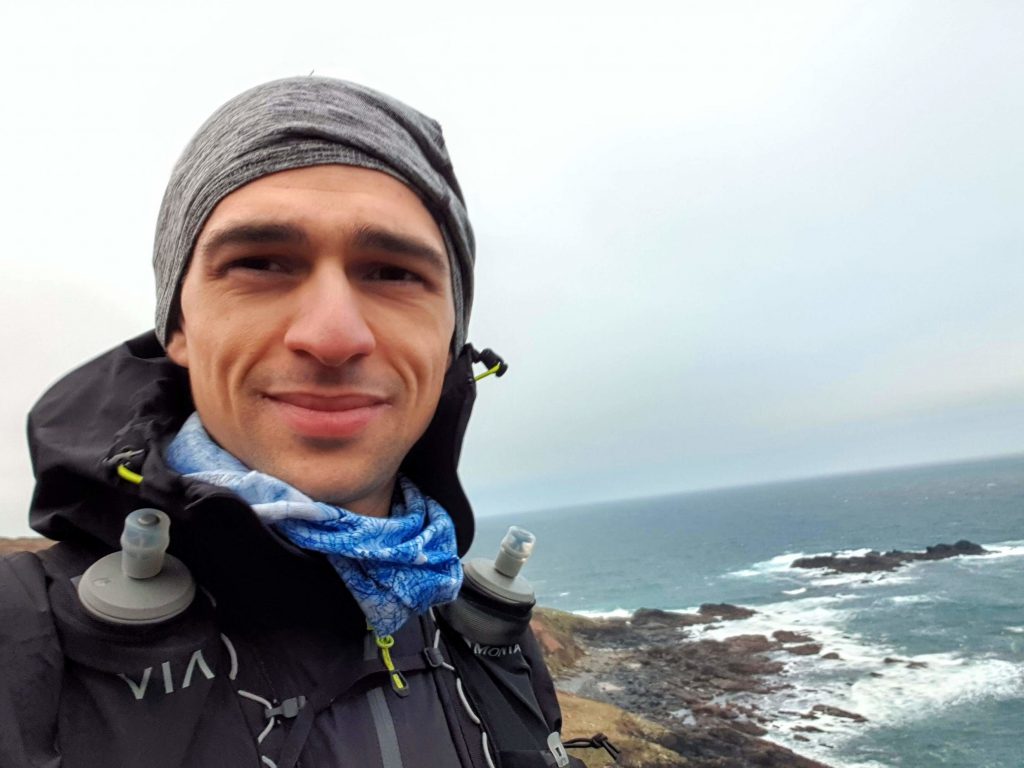
I bumped into Stephen Cousins on the approach to the beachfront, who invited me to stop for a minute to speak to the livestream. “That was horrible”, I exclaimed in a jocular fashion, pointing back toward the path to Pendeen.
I headed off at a good pace, along the promenade, following a few rare route markings, before the Arc valets picked me up and ran me into the final aid station. I wasn’t as talkative this time around: my brain was a little frazzled, and I was busy preparing my mental checklist of actions.
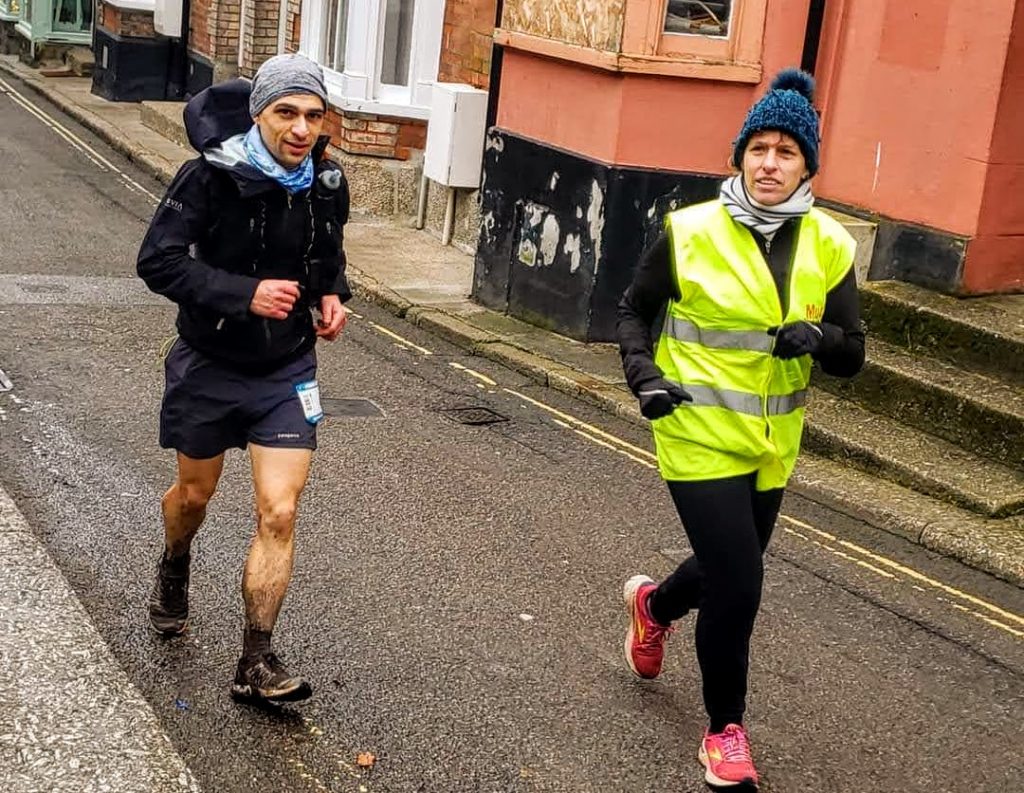
As I entered the aid station, I was greeted by a beaming volunteer, who took my order for chilli and soup, and congratulated me. “The cut-off isn’t until 2pm – you’re in great time!” she reassured me.
The cut-off, I thought? Hold on right there; why is anyone talking to me about cut-offs? Just how long had I taken to get to St Ives?!
I checked the remaining distance on my race plan, and did some quick mental calculations. I was behind schedule. Well behind, by at least an hour. I didn’t want to figure it out precisely, I just wanted to get the heck out of there. I wolfed down my food at lightning speed, removed a shoe to try to dust off some of the accumulated debris (which was so utterly hopeless I didn’t even bother trying with the other foot), moved some of the contents of my final bag of nutrition to the front of my pack (I hadn’t consumed much up to St Ives), and hotfooted it back out of the aid station. I really had to shift up a gear.
It began to sink in just how much running still remained. I may have broken the back of this race, but it was far from over. At least it was flat, easy road running from here on. I was fast on this sort of terrain, and I’d make up loads of time, I told myself.
Approaching Hayle, I thought to double-check the charge on my Garmin, and got a huge shock when I saw that only 14% remained. No, 13% – it had just ticked down whilst I was staring at it. I pulled over to the side of the road, took off my pack, pulled out my dry-bag and dug around for my portable battery pack. I couldn’t find it. Confused, I dug around my pack instead, but still couldn’t locate it. I checked my dry bag a second time. No, not there. I racked my brain: had I removed it at Land’s End? Possibly, I couldn’t remember. Had I accidentally put it back in my drop bag instead?
I sat there, contemplating this possibility, and swore loudly, just as a family I’d run past a couple of minutes ago strolled back past me. If I had no charger, that meant in a couple of hours I’d lose navigation. And my route recording, of course; but the bigger concern was the navigation. Without this, there was a real likelihood that I’d lose significant time to routing errors. Goodness knows when I’d finish – I wasn’t at risk of being timed out, but I was certainly at risk of taking a long time to finish. Was it possible that I might even take longer than 30 hours? Fucking Garmin and its shitty battery life!
I remained seated on the grass, looking out over this picturesque little village, taking a moment to control my thoughts and feelings. I accepted the outcome, whatever it was, and then emptied the contents of my pack onto the grass verge – I had to be sure. The last item to fall out was a transparent plastic bag, containing a coil of wires wrapped around a black battery pack. I was back in business.
I remained seated for a while, allowing my watch to charge, and just soaking up the atmosphere. It had turned into a most pleasant Saturday morning: the high wind gusts that had plagued us overnight had ceased, for now, and the sun had come out. It was lovely.
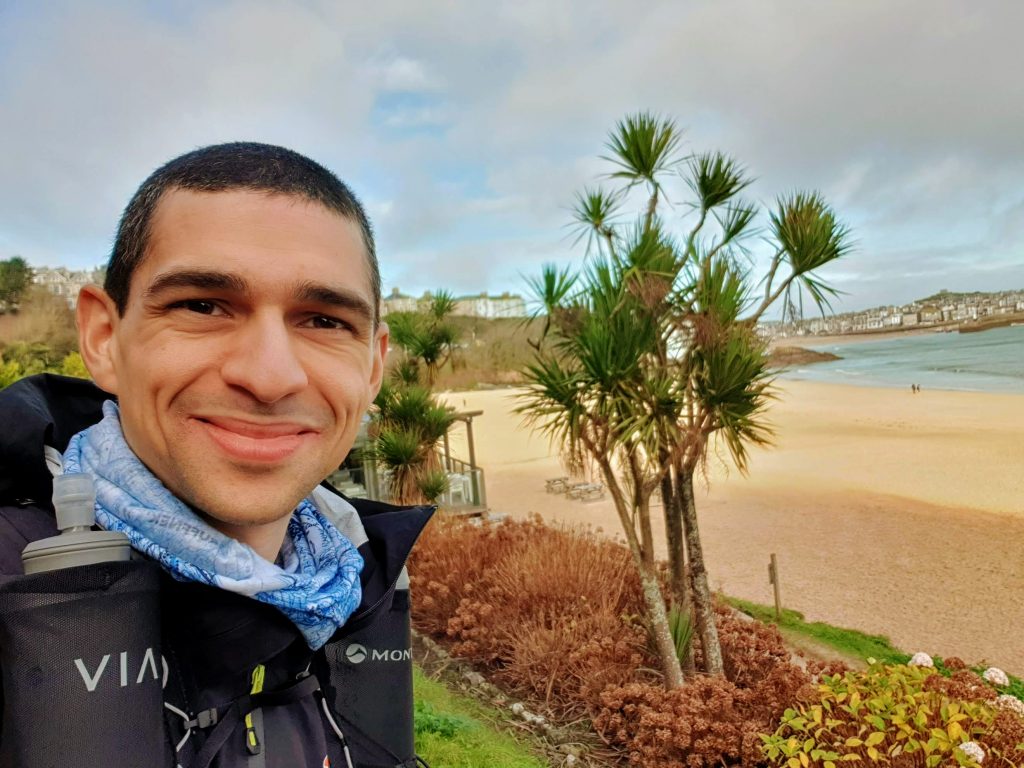
I re-packed my pack, stood up, and began walking, holding my charging watch delicately in my hand. Another competitor jogged past me, and we got talking about something-or-other, and matched pace. We ran together for a while through Hayle, discussing watches, ultras we’d run; all the usual stuff that runners do. After a short while, despite his outward demeanour, I could tell he was struggling to keep pace; so, when he engaged in discussion with locals on the outskirts of town, I knew that was his way of peeling off, and my cue to push on and start racking up the miles.
It was at this point that I realised the roads had ended, and I was back on the coastal path. I thought back to how I’d garnered the impression that the St Ives-Porthtowan section was all flat road. I couldn’t remember where that’d come from, but it clearly wasn’t accurate.
This was around about when I hit the dunes. The “Dunes of Doom”: I’d completely forgotten about them. Someone had reassured me they weren’t as bad as they were sometimes made out to be, so I plodded over them with an optimistic outlook, while sand blasted into my face by the winds that had clearly returned from their lunch break. Exiting that section, I thought the dunes were over: no trouble at all, I reflected, and hoped for a return to road. That wasn’t to be.
The real Dunes of Doom loomed ahead, and consisted of some kilometres of rather significant hills of sand, dotted periodically with slate waymarkers, which aren’t always the simplest to find. Whilst the GPX route keeps you roughly on track, it’s not accurate enough to tell you precisely which dunes you need to summit and which you need to skirt, so it’s a bit of a route finding exercise for the uninitiated. Meanwhile, the wind really had picked up again. The hood of my Montane waterproof jacket was thrashing against my face with a vengeance.
Once through the dunes, it was a return to the usual trails. These, though, featured a little more gorse, which was scratching my legs something rotten. On more than one occasion, I grabbed onto gorse for some support while descending, the marks from which are still visible on my hands. Otherwise, this was a fairly fast trail stretch, more runnable than much of what had preceded it.
I used the mental break to try to calculate my expected finishing time. This is an activity that most runners struggle with near the end of an ultra, when the simplest of math can become fiendishly difficult. As it stood, I reckoned I was on for about 28-29 hours; but, of course, this depended on the terrain that still lay ahead. What if there were more surprises to come? It sunk in that, in the worst case, I could be pushing the 30 hour mark, after which the reward transitions from a gold to a silver buckle. I had absolutely no intention of exceeding 30 hours. Nor did I want 29-hours-something. I didn’t think I could run sub-28 at this stage, so I was absolutely determined to run a 28-hour-something time, no matter what.
In a mild panic, I picked up the pace. Each runner I saw, I set my sights on, pushed on and overtook, and then set my sights on the next. And so it went, again and again, until we hit the big hills. There were a series of 4 or so sharp descents and ascents up steep steps. I probably lost a little time on the descents, but hammered the ascents as best I could: I simply had to make 28-hours-something. I reckoned it might be 28:45 the way I was going, so it was going to be tight – and I still didn’t know what remained.
I hammered down the descent into Portreath, overtaking a few runners before passing the Portreath crew stop. Someone left the crew stop just after me, so there were a good few on my tail. The route in the town then switched back, and I was presented with a road ascent to the right, and a footpath descent to my left. I picked the road, then stopped a little way up. I wasn’t sure. I headed back down, and took the footpath instead. Halfway down, I still wasn’t sure, and headed back up. I stood beside the fork, scratching my head, as a couple of runners approached me, and I motioned to ask the way. The road to the right, they signed. Off I went, at pace, to make up for my indecision.
The road snaked around, and continued to ascend. I spotted a man and woman running together ahead of me – after my exertions over the hills, they looked in better shape than I felt. I resigned to sit on their tail for a while, but nonetheless I found myself gradually making ground on them, and as we veered off the road back onto trail, I passed them. The woman (the 3rd lady I believe) commented that my gait was looking good, and I returned that they’d soon overtake me again in a minute. It was all very friendly; however, at this stage, I had no intention of ceding places.
The trail took me past a couple more abandoned mineshafts, and dropped down into Porthtowan. This was it. I could see three runners ahead of me: Danny Fox, Steve Adams, and Duncan Oakes. I cranked into another gear. I was peripherally aware of the supporters cheering and bell-ringing along the route through Porthtowan, but I was focussed and pushing hard now – I wanted to take all three places. I was very aware of the importance of overtaking them at significant pace, so as to discourage them from trying to follow me. So I was flying when I overtook the first two on the descent, and felt confident they wouldn’t feel it worth trying to catch me – but that left one runner still ahead of me, and he was motoring, no doubt sensing the finishing line.
My first instinct was that I wouldn’t be able to catch him; and if I did, it would take so much effort that I wouldn’t be able to hold the place. But then we hit a gradual ascent, and I found myself making up ground again. This was it – I found another gear and flicked into an all-out sprint. I shot past him, cornering left and then right onto the road I’d driven from my lodgings in Mount Hawke to the race start at the Eco Park. There were volunteers along the route, who I think were commenting on my pace; but I only had tunnel vision for the yellow arrow 200 metres along the road, pointing up the final hill climb to the Eco Park. I was really motoring.
Up and over the verge mound, onto the trail, and up. It was one steep climb up the circa 60m hill; a switchback path snaking past gorse and yellow flowers. I thought I could hear the sound of twigs snapping from my competitors hot on my heels, but I didn’t look behind: I didn’t want to give even the faintest sign of weakness. I powered up that hill like my life depended on it, straight past Stephen Cousins at the top congratulating me on the gold buckle, sprinted across the grass, past the Eco Park’s cafe, and raised my arms as I passed underneath the bright blue Raidlight arch marking the finish of the race.
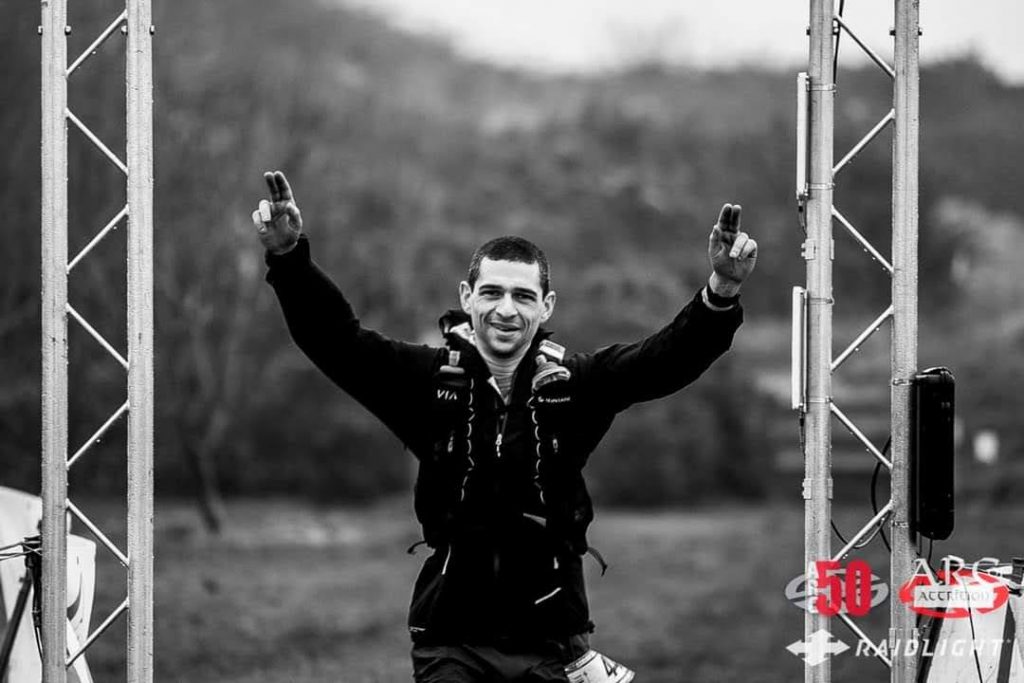
The photographer, caught off-guard, jumped to his feet and started snapping photos. I finally looked behind me, expecting to see one of my competitors decelerating over the finish line, shaking his head from having just been pipped at the post. But there was nobody there.
I accepted my buckle, and had my photo taken in front of the Arc’s finishers board.

Duncan Oakes finished 4 minutes 17 seconds later. I could have walked that last stretch. I could have walked that last hill. Heck, I could probably have walked from Porthtowan.
I finished in 28 hours, 12 minutes, 31 seconds, in 31st place.
The Arc is a challenging sod. A lot of it is run overnight, during winter, fully exposed to the Atlantic winds. The stretch to Marazion is technical and rugged. The stretch to Land’s End is even more technical, with only short runnable sections. The stretch to Pendeen is still fairly technical, until you get to Pendeen, when it’s a case of sticking with “the path” as best you can until St Ives. It’s almost impossible to avoid slipping and falling on this section, so it’s more a case of ensuring any falls you do have are sufficiently mitigated to avoid serious injury. And whilst arrival into St Ives logically feels like it must be the end of the race, there’s another 35km of coastal trail to go, including several km of significant sand dunes, and finishing with a series of big hills. And all that with only 4 aid stations and 1 drop bag, for those amongst us who run uncrewed.
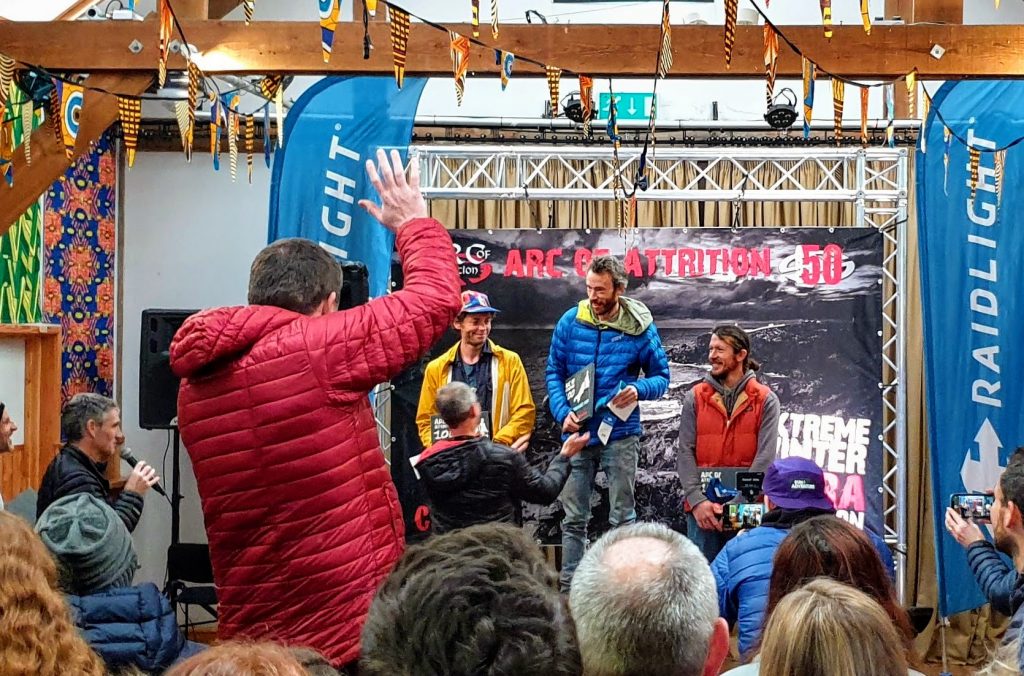
What it does have, though, is some seriously impressive organisation, comprising over 200 beaming volunteers & Arc Angels, working their socks off to support you around the course. If you’re going to put on a winter 100 miler around this tough, rugged, remote course, then the Arc is exactly how to do it.
Written by Alec Burns - https://uphillalec.substack.com/
Location: Capel Curig, Wales
Time/Date: 9am, 11 September 2021
Distance: 50.38km (by my watch)
Elevation Gain: 3,438m/11,279ft (by my watch)
For my first ultra distance race, and in fact first race of any description since a brief foray into running back in 2018, I couldn’t have picked a better one than Ultra Trail Snowdonia. “Beautiful beyond belief. Savage beyond reason” is the tagline, and it fits.
After a 2 year gap since my 6 month running career in 2018, I got back onto the trails in November of 2020. Originally signed up for a much flatter 50k in the Peak District, my enthusiasm outpaced my body and I went down with an overuse injury in March, keeping me out until early July in terms of meaningful training.
The obvious thing to do when recovering from injury is to sign up for what must be one of the UK’s, if not Europe’s most difficult 50k races, especially when you’ve only about 8 weeks left to train before tapering. But, Snowdonia has become maybe my favourite place in the UK since moving here from Australia and I couldn’t resist.
Based on my recce runs, I aimed to finish in under 10 hours, which represented what would be a very good day out. Ambitiously, I thought that if I had a flawless day, and everything (including what I couldn’t control) fell perfectly into place, that under 9 hours was possible.
Preparation
Arriving in Snowdonia on the Friday before race day Saturday, I went through the kit check, picked up my number and GPS tracker, all very smoothly handled by the excellent team of volunteers at race HQ. Having already received the briefing in the form of the race handbook via email, all that was left to do was turn up for the start in the morning. We went for a nice pub dinner in Anglesey, and I very responsibly did not have a beer.
Admittedly in the morning the nerves were starting to kick in. Arriving in the car park up the road from the start line, I quickly hopped out and started my final bits of prep, more in need of an outlet for nervous energy than anything else. I even put sunscreen on, with the forecast having said there was a chance it would clear up and be sunnier in the afternoon (it was not).
I joined the crowd milling around race HQ, most giving off the same quiet, expectant energy ahead of what I’m sure everyone knew was going to be a long and challenging day. There was a quick group photo then we all moved up to the starting area across the road from the Moel Siabod Cafe (thoughtfully positioned there to avoid 300-ish runners immediately crossing a busy road). Another few tension-laden minutes of waiting later, race director Michael Jones counted us down and off we went.
Start to CP1
The course began with a short, but runnable incline on a wide, gravel road that gradually narrows until reaching a stile as the course turned more decidedly uphill, which signalled when mortals should probably commence hiking. I ended up quite near the front in the starting area, so happily let people pass me along this section as I maintained not much more than a gentle jog.
Once through the stile the poles were out and I joined the conga line making its way up Moel Siabod. We had almost perfect running weather at this stage and throughout; overcast, decent breeze, with the occasional bit of drizzle and a temperature not much higher than about 15 degrees.
The climb up Moel Siabod isn’t ridiculous compared to the other mountains of Snowdonia. The path is relatively clear, not technical and gradual enough to maintain a good hike on.
Trying to keep a lid on my effort level early on I fell in with a small group and chatted on the way up, talking about what we knew about the course ahead and other events run in the past. As an Australian I got all the predictable questions once they heard the accent, which I don’t at all mind answering and makes the conversation easy when the alternative is to think about how hard Pen Yr Ole Wen is going to be.
As we neared the summit the low cloud closed in around us and we became a little more reliant on the orange way markers to make sure we weren’t drifting. Having been up there a couple of times before I recognised the approach to the cairn and looking at my watch realised I was already 10 minutes up on schedule. I chalked it up to an excited start, extra freshness in the legs from tapering and not losing time on nav checks as I had on the recce.
As with most climbs, this was followed by the descent. The course down the North-Western side of Moel Siabod is temptingly runnable, being mostly short grass with just the occasional rocky patch. Ian Corless was here taking photos, so I was careful to look confident skipping over the rocks as I passed him to avoid ending up on a blooper reel. Following a fenceline down and through a couple of stiles, I very deliberately took it easy in hope of saving my legs for the mountains to come.
There was only one brief little climb on this section, interspersed with slightly more technical sections and occasional bog. If I have a running specialty, it’s probably technical descents, and I managed to pass quite a few people when the terrain got a bit rougher. This was a nice confidence boost, even though a fair few cruised back past me on the road leading into CP1.
I went through CP1 (~12.5km) in 1hr45min, 15 minutes faster than planned. At this stage I was happy with that, although I was aware that it likely signalled I was going a bit quick so early in the race.
CP1 to Glyder Fawr, Y Garn, CP2
Already well ahead of schedule, I walked the entire way up to Pen-Y-Pass, most of which I had walked on my recce anyway. Much like Moel Siabod, this section is all on a very clear and relatively gradual path that allows for good hiking speed without a huge effort. I saved my legs for Glyder Fawr.
Once across the road at the youth hostel, the climb up Glyder Fawr begins immediately and feels much more serious than Moel Siabod. The path is far less well trodden (in some parts non-existent) and in places a scramble over rocky outcrops.
I knew what lay ahead so just kept a steady hiking pace and chipped away at it. I got talking to an Irish guy with a road running background, he hadn’t recce’d the course so I gave him a warning about Pen Yr Ole Wen, saying my strategy was to keep the effort level low until I was past that climb, being in my opinion the toughest section.
It was on the way up Glyder Fawr that it felt like Ultra Trail Snowdonia had really started after the warm up on Moel Siabod. It’s steep, quite technical in places and hard to avoid the effort level rising. Checking the elevation on my watch it seemed I was stuck at 600-something metres for a long time.
As we got into the last third of the climb I had started gaining on a small cluster of runners ahead, managing to sneak up through the low cloud and pass them one by one before the summit. Another nice little confidence boost, but perhaps effort that would have been better saved for later in the race as I could already feel faint twinges in my quads, hinting that cramping might occur sooner rather than later. I reached the top in 3hrs5min, 30 or so minutes faster than planned, which set off a little alarm bell about pacing.
Lack of experience, and my enjoyment of descending however, won out over common sense. I let myself pick up a bit of speed coming down the scree on the other side, passing another couple of runners and just generally having a good time hopping from rock to rock and doing imitation ski turns in the loose gravel. I did slow right down and walk across to Y Garn though, giving my legs a break before whipping the poles back out for the climb.
The approach to Y Garn from Glyder Fawr is not at all technical or particularly steep, you just walk straight up it, making it tough in its own way because there’s no excuses for not keeping a decent pace. I did note that in the poor visibility the route had been altered slightly to follow the left hand path to the top, rather than the one that skirts the Eastern edge above a more or less vertical face.
The course then followed the well trodden path down to Llyn Idwal and CP2. Very steep and technical in places, especially with just the right amount of drizzle to make every rock a slippery death trap. This section really hammers the quads as you come down the big stone staircase, so I didn’t rush and happily jogged into CP2. The view coming down this part is stunning on a clear day, but I wasn’t bemoaning the layer of cloud keeping conditions cooler.
I got into CP2 (~24km) in just under 4 hours, way up on schedule (I had allowed up to 4 hours just to reach the top of Glyder Fawr) and feeling good. I had planned to reach this point with plenty left in tank, but the little twinges in my quads on the climb up Glyder Fawr were concerning. I took a 7 minute break here, refilled my water and received a welcome can of coke from my highly professional crew (my endlessly patient fiancee).
CP2 to Pen Yr Ole Wen Summit
I was excited for, and dreading Pen Yr Ole Wen in equal parts. The most challenging climb of the race, gaining 700m in elevation over roughly a mile of the most technical terrain on the course. It involves sections of scrambling with some exposure, which I enjoyed but my legs did not. Headphones with my special UTS playlist went in. I felt like I might need some encouragement in the form of Parkway Drive, and I was correct.
Not much more than 10 minutes into the near vertical ascent the cramps in my quads were well and truly kicking in. I was honestly surprised at the severity given how good I had been feeling in CP2, and having drunk plenty of water and taken numerous salt tablets by this stage. There was nothing to be done about it, I just kept moving and let the cramping happen. They faded in and out but didn’t seem to be worsening, and after an eternity the ground levelled off and the climb was done. Somehow I got up it in 1hr8min, 2 minutes faster than planned.
Pen Yr Ole Wen to CP3
The strategy was always to use the stretch from Pen Yr Ole Wen to Carnedd Llewelyn as a rest. I knew I would be knackered after the final ‘big’ climb of the race, so especially after my 1 hour cramp-a-thon I backed right off, taking time to eat and drink as I made my way over the Carneddau.
On fresher legs, this can be a fast section as it’s largely flat and runnable. There are a few bits that are rocky enough to slow you down, but I had made it from the Pen Yr Ole Wen summit to the top of Carnedd Llewelyn in well under an hour on my recce. That was not the case for me during the race however, as I mixed walking with shuffling depending on how bad the cramping was.
The group that had tailed me up Pen Yr Ole Wen had long since made their way off into the mist and I spent this entire section on my own. I generally prefer running on my own, and it was particularly welcome at this point as it meant I could cramp-waddle shamelessly.
On the day, visibility was especially poor and I was grateful for my OS Maps subscription. While the course marking was excellent, it’s easy to drift on the more open sections while you pick your way through the rocks. But, with half a flapjack in one hand and iPhone in the other I worked it out. Nav is easier when you’re not moving very fast anyway.
Neither of the climbs up Carnedd Dafydd or Carnedd Llewelyn are especially difficult in isolation despite the loose, rocky terrain, but with 30-ish kilometres and the best part of 3,000m of ascent already in the legs they were slow going. I started kicking rocks more and more often as my feet dragged, and each slip on a loose rock risked triggering another spasm in my quads.
Finally coming down out of the cloud I spotted a couple of runners on their way toward Pen Yr Helgi Du. I had the cramping under control (not really) so risked a light jog down and across the rocky sections that precede the scramble up. Pen Yr Helgi Du from this approach is a very short, but very technical ascent that really falls into the category of bouldering more than it does any form of running. Having caught up the runners ahead we briefly joined forces to spot the markers showing the correct path to the top.
Checking my watch I saw that I could still reach CP3 (~35km) in under 7 hours, my final benchmark for a sub-9 hour finish. I knew at this point, with my legs in the state that they were, that under 9 hours was not happening, but there was a glimmer of hope. ‘The damage is done’, I told myself, ‘going slow will hurt just as much as going fast’, so I bombed the whole way off Pen Yr Helgi Du.
With my heels nearly hitting the back of my head, flying past the mountain ponies, legs screaming the whole way down the grassy slope, I arrived at the final aid station in 6hrs56min, which at the time felt a triumphant victory. The outstanding volunteers refilled my soft flasks, gave me a bag of crisps and pointed me in the direction of the final 15km stretch to the finish.
CP3 to Finish
This section starts by contouring around to the South of Pen Y Llithrig Wrach on a mercifully flat gravel road. This was a mix of walking and shuffling for me dependent on cramp intensity despite having envisioned being able to sustain a healthy run in my race planning.
This being the only part of the course I hadn’t seen before, I naively thought the next part of the route around the reservoir might be a nice, well maintained path. In what I suppose is not a huge shock, it was not.
Coming off the gravel road, there was definitely a path, but much more undulating and certainly rougher than I had hoped. Progress became more stop-start as I alternated between running until my quads cramped up, then stretching them out, but progress is progress. I finally relinquished hopes of finishing in under 9 hours, and focused on maintaining momentum.
The time spent going along the edge of the reservoir did however serve up the best views of the day, with cloud having obscured them from higher up. It was a gorgeous bit of trail with mountains either side, made all the more enjoyable by knowing the hardest work was behind me and my sub-10hr goal time was safe.
Coming around the Northern end of the reservoir and heading East there was a little climb then a nice gentle descent into the forest, the path winding downhill through the trees which was a nice change of scenery. My legs were still a nightmare but finish line fever was creeping in and proved to be a reasonably effective painkiller. During this section I went up to my waist in a bog, which I couldn’t help but find pretty funny at that point. I dragged myself out, quite satisfied that the mud would add to the hardcore mountain runner aesthetic.
After the final tiny hill it was all downhill from there and mercifully the cramps finally subsided. I was caught up by a guy who much like me had only started running ultras this year, who confirmed that this race was much harder than some of the other ultras he had tried. We had a quick chat about the merits of various brands of trail running shoes, and I gave it a final push down to the road through Capel Curig.
That stretch of road can’t be much more than about 400 metres, but seemed to last forever. The applause from earlier finishers on their way back to the car park was much appreciated, but I couldn’t muster much more than a thumbs up to show it. And then, finally, past the Moel Siabod Cafe, through the gate, and over the finish line in 9 hours and 49 minutes.
Thank you to all involved in organising. It was brilliantly run throughout, I unreservedly recommend this race to anyone who fancies the challenge. The amazing staff in the aid stations were helpful and efficient, the course was extremely well marked considering the terrain, from my perspective as a runner it couldn’t have been better.
Gear
Shoes: La Sportiva Mutants
These worked really well for me in training including both recce runs (in dry conditions), and were comfortable throughout. They are certainly robust if a bit clunky, the grip is beyond reproach on softer surfaces. However, I did have a few slips on wet rock, potentially owing to the existing wear on the outsole. If I could do it over (and I intend to), I would probably opt for a shoe with shallower lugs and more surface area to better handle the rocks which make up the sketchier parts of the course, something like a VJ XTRM (which I saw a fair few pairs of on other runners).
Pack: Montane Gecko VP 12+
I previously held up the Salomon ADV Skin packs as the gold standard having used one back in 2018, and had been using the new 5L version in training until the back compartment suffered a catastrophic blow out resulting in the loss of various bits of kit. In a rage I bought the Montane pack and it was a great decision. The fit is amazing, it barely moves even when fully loaded, and has all the storage where you want it (including zippered pockets for items you don’t want to risk bouncing out).
The mandatory kit list was the same for all UTS distances up to the 100 miler, and the pack fit everything in with room to spare. I also wore the Compressport free belt pro, but only for the elastic loops to carry my poles when folded.
Poles: Black Diamond Carbon Z
I’ve only ever used one set of poles so I don’t have a frame of reference for comparison, but they did the job, and there were definitely times when they were picking up the slack. When folded up and stowed away they’re light enough that I didn’t notice they were there. I did see a lot of Lekis on the course though, which suggests they’re an equally good choice.
Watch: Coros Apex 46mm
A relatively recent purchase as I didn’t trust my ancient Garmin forerunner to last potentially 10hrs+. In 9hrs49min of full GPS and navigation mode it used just 23% of the battery life. As the course was so well marked, the navigation mode was really just a failsafe, but was worthwhile as it did prompt me to double check my position on the OS Maps app when visibility was exceptionally poor. The built-in altimeter was also helpful for knowing how far up a climb I was when cloud obscured the summit. For the price I don’t think there’s a better watch out there for this kind of race.
Written by Richard McChesney - http://richardwalkslondon.com/
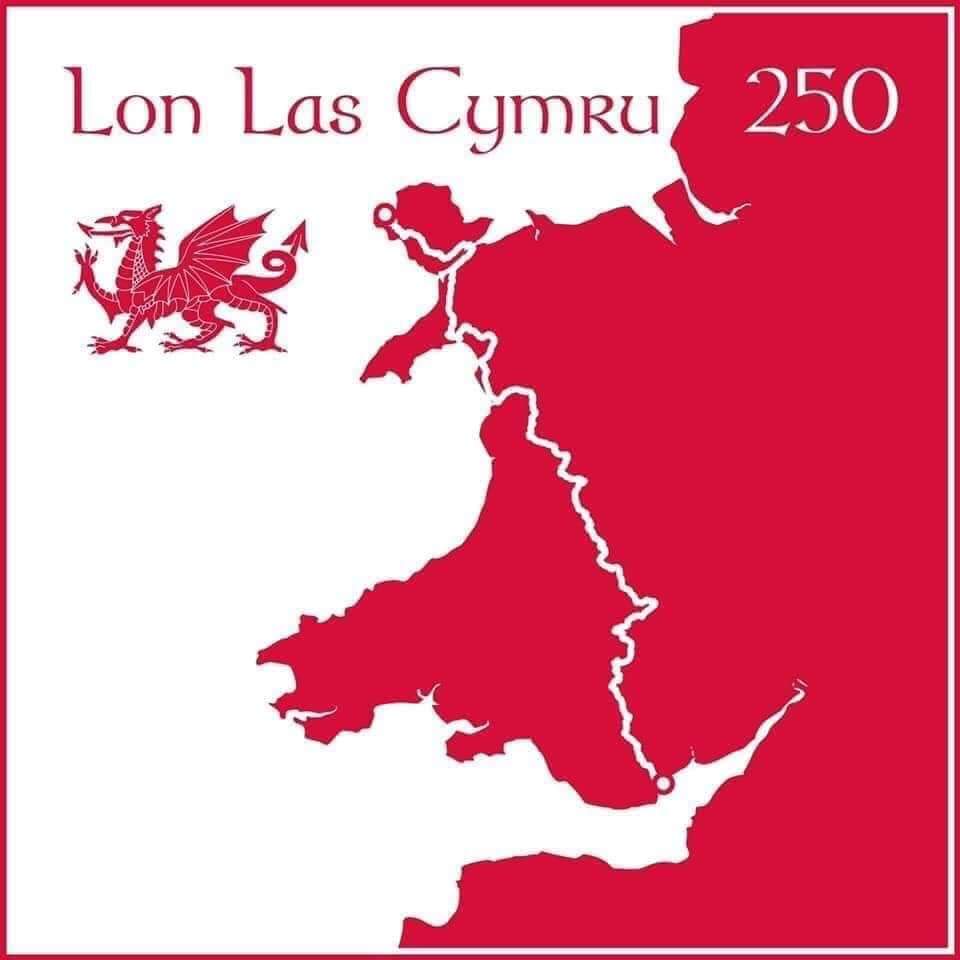
“I don’t remember there being a castle in Adelaide” I thought to myself as I realised I was walking beside a castle having found my way on to a road after being unable to exit Bute Park in Cardiff due to a locked gate just a few miles from the finish of the Lon Las Ultra.
Having spent the last almost 90 hours walking to Cardiff, for some strange reason I thought I was in Adelaide (Australia). And on reviewing the course map while writing this race report, I also realise that I shouldn’t have been in Bute Park anyway but should have crossed over the River Taff a mile or so earlier.
The Lon Las Ultra is a 253 mile (407km) running race from Holyhead in Northwest Wales to Cardiff in Southeast Wales. It follows an almost diagonal line across the country climbing in excess of 5,500 metres and dropping the same – starting and finishing at sea level. It is supposedly a national cycle route but some of the hills are so steep, going both up and down, that I can’t imagine anyone cycling it – although apparently people do.
The 2021 edition was the third running of the Lon Las Ultra and to date only nine runners had finished the challenge. I attempted it in 2019 – the year of the horizontal rain – and only managed about 140 miles before dropping out mainly due to being cold and wet, but also due to lacking the mental strength to complete the event.
2021 would be different!
Holyhead to Criccieth – 0 to 60 miles
Unlike 2019 we woke up to a mild day and 29 runners assembled beside the railway station in Holyhead just before 7am for race director Mark Cockbain’s inspirational pre-race briefing – something about “… most of you won’t finish …” – and a pre-race photo.
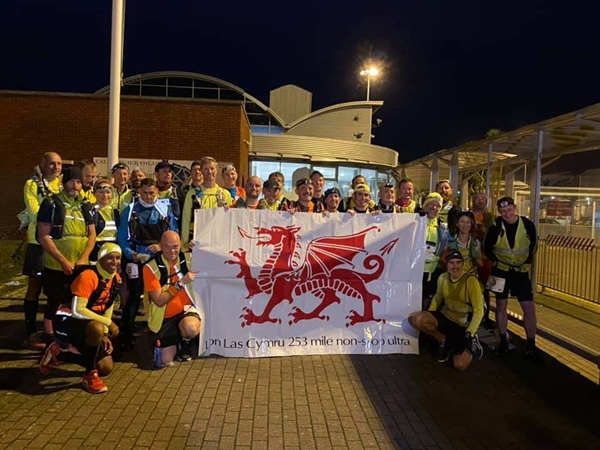
I set out at a comfortable pace at the back of the field. As usual I was the only walker in a field of runners and whilst I expected to catch some of the runners during the next 3 ½ days, I had no intention of going too fast early on.
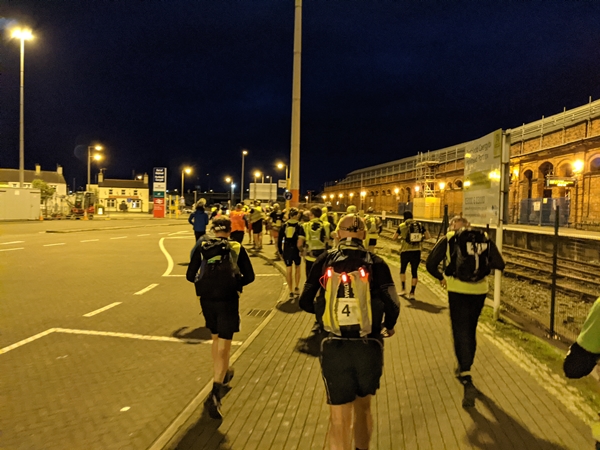
I was surprised therefore to find myself playing cat and mouse with a few runners during the morning and early afternoon. One of those runners was David Wright who I had spent a lot of time walking with during our 2019 attempt – David had dropped out at a similar place to me in 2019 after being found asleep in a ditch by a passing horse rider.
My pace through the morning was a very consistent 7km (4.35 miles) per hour and I arrived at the first checkpoint at Menai Bridge (31 miles) in 27th place just after 2pm. The Lon Las Ultra is a ‘self-supported’ event – meaning that not only are odd-numbered checkpoints outdoors but all you get at any checkpoint is water. Checkpoints 4, 6 and 8 (100, 150 and 200 miles) are indoors meaning that they are warm and you have the opportunity to sleep if you want/need to, but other than that the athletes are expected to fend for themselves.
I was in and out of the Menai Bridge checkpoint in about 4 minutes, just enough time to refill my water bottles and get some more food out of my race backpack and stuff it into my pockets, waistbelt, etc.
The first two legs were the longest of the race but also the easiest. No serious hills, not too tired (yet) and mostly in daylight. The only real highlight for me during the first day was the small town of Caernarfon which I arrived at around 4pm. In 2019 I had taken a short detour off the course at Caernarfon to buy McDonalds for an early dinner, but this year I decided that I would prefer Fish n Chips and used Google to identify all the local Fish n Chip shops. The one with the highest star rating was only a block off the race route so I decided that would be my dinner for today. When I arrived the door was open but the owner advised that they were closed until 4:30pm. I told him that I was in a race and couldn’t wait around, and I asked for his recommendation for another Fish n Chip. Not wanting to recommend his competition he suggested that I continue through to Criccieth, but I knew I wouldn’t get there for another five hours and I wanted food now. He said that there were plenty of Fish n Chip shops in the square, so I walked a short distance further and stopped at the first Fish n Chip I found – wrong choice!
The chips were great, but the fish wasn’t. I ate about half of the fish before binning it and ate the remaining chips while walking. I also bought a can of Coke but decided that I hadn’t yet walked far enough to drink Coke (usually preferring to stay off highly processed sugar until at least 12 hours into any race), so I put that in my backpack saving it for later.
‘Later’ was when I reached 50 miles, which I passed in a respectable 12 hours and 3 minutes. I had started to struggle a little and decided to reward myself with a can of Coke just as David Wright caught me up again. This was perfect. Between the Coke and the faster pace that David was running/walking I regained my enthusiasm and my pace immediately picked back up. David and I stayed together for most of the remaining ten miles through to checkpoint 2 which I arrived at at 9:19pm – 14 hours and 19 minutes after race start.
Criccieth to Dolgellau – 60 to 100 miles
The Criccieth checkpoint is at a bus stop beside the sea. Unlikely 2019 when it was wet and cold, the weather was still reasonable but knowing that we were heading up into the hills for the night, and with rain forecast, I put on some warmer clothes and replenished my backpack with my food for the next 40 miles. All up, I was at the checkpoint for about 15 minutes, leaving in 23rd position with three other runners just in front of me.
I love walking at night and really enjoyed the 20 miles through to checkpoint 3. Almost immediately upon leaving Criccieth there is a long steady climb before a descent into a town called Porthmadog (I love the Welsh names ) and soon after Porthmadog we hit the first really big climb of the race – a 250 metre climb over about 4 kilometres followed by an even steeper descent to checkpoint 3.
I really enjoyed the climb. My only regret being that it was dark, and we were missing what I expected were fantastic views. The rain stopped mid-way up the ascent, but rain was replaced by mist that made it difficult to see too far ahead. Not to worry, I seemed to negotiate the route without any problems and arrived at checkpoint 3 at 3:39am to find two runners suffering more than they should be at this stage of the race. Tom Garrod, especially. Tom was planning on doing a double Lon Las Ultra as a fundraiser for a cancer charity and with only 80 miles of over 500 completed so far, he was not in a happy place.
Having refilled my water bottles, I wasn’t planning of hanging around at the checkpoint and convinced Tom to walk with me, figuring that if he got moving and had me to talk to he would start feeling better. Unfortunately, we spent too much time focused on conversation and not where we were supposed to be going and we missed a turnoff soon afterwards. In the totality of the race, this didn’t matter but it did mean that we accidentally took a shortcut of about 1 ½ miles (2 ½ km). Something I felt guilty about for the rest of the race, once I became aware of it, even though I would more than make up the missed distance during the remaining days when I got lost on various occasions.
The miles flew by and soon we were walking through a small town at around 5 or 5:30am when we came across a shop with an open door. I think the shop was a sandwich shop, but I didn’t stop to check it out. Tom did however, and I kept walking catching up with Javed Bhatti a few minutes later. Javed had also stopped at the shop and confirmed that it was selling sandwiches. Javed is a hugely experienced ultra-distance runner, and I took the opportunity to pick his brain about my ongoing problems with sleep deprivation during long races.
Sometime after 6am I arrived at Barmouth from where we were diverted on to an A road heading inland towards Dolgellau. The race should have headed across a pedestrian bridge over the river but unfortunately the bridge was closed for maintenance, and we had to walk (run) along a semi-busy road without footpaths for the next 5 or 6 miles rather than the pedestrian trail on the other side of the river. I didn’t have any problems along this stretch, but Javed narrowly escaped being hit by a car and decided that that was enough for him – he withdrew from the race at the 60 mile checkpoint.
I started to struggle again during this stretch despite having drunk a bottle of Coke at Barmouth, and I decided that I would have my first sleep when I got to Dolgellau. The Dolgellau rugby club being our first indoor checkpoint and therefore our first opportunity to have a sleep in warm conditions, and our last opportunity until 150 miles. I arrived at Dolgellau at 8:53am (25 hours and 53 minutes after the start) but with only 157km on my watch – due to the shortcut I had taken and also the diversion meant that the 100 mile checkpoint was actually at 99 miles. I was now in 16th place. Not too bad, but a long way still to go.
Dolgellau to Rhayader – 100 to 150 miles
After sorting out my food, clothing, etc, I tried to sleep but I no longer felt tired, and both my hips were too sore for me to get comfortable enough to fall asleep. I lay in my sleeping bag for about 20 minutes before giving up and left the checkpoint after about 90 minutes total break.
Immediately after leaving the checkpoint the route heads up hill again, rising from near sea level to 425 metres in just five miles, and then dropping back to 100 metres just as quickly. I don’t particularly enjoy hills (major understatement) and for this reason I don’t spend anywhere enough time training on hills. And because of this, my quads and shins were really struggling with the downhills. I didn’t mind the ups, but the steep downhill sections were slower than the uphills.
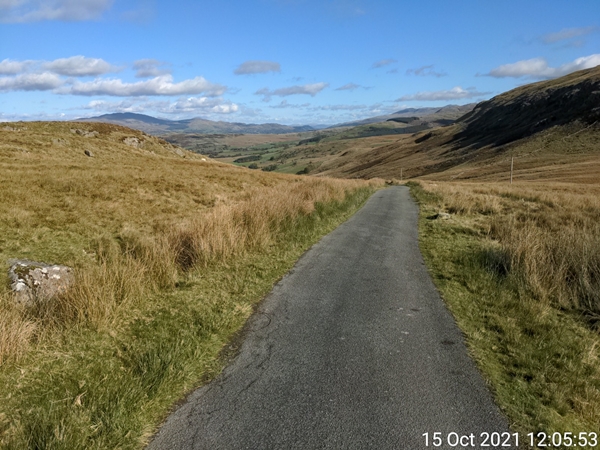
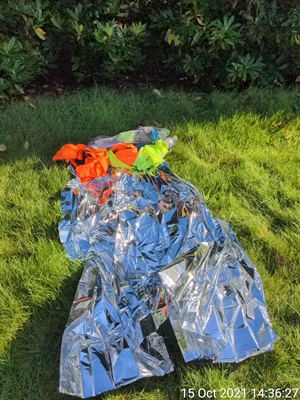
We walked together for a while but Steve was struggling and considering dropping out of the race. He decided to stop and have a rest and something to eat, leaving me to continue on alone.
Soon after, I think probably around 4pm’ish I stopped in a town called Machynlleth. Firstly I went to the Co-op to buy some painkillers in the hope that they would reduce the pain I was feeling in both my hips, and then further down the road I purchased a sausage and chips at the local Fish n Chip shop – the same shop I stopped at after my visit to the launderette during the 2019 race. As with 2019, they were the best sausage and chips I had eaten in years, and at only £2.90 I couldn’t believe the value for money!
I remembered Machynlleth from 2019 as being the start of the long climb up to the halfway point. The big difference this year was that I would be making that climb (from close to sea level up to 570 metres) in daylight and I was looking forward to seeing the views that I had missed last time.
I wasn’t disappointed either. Over the final mile or two to the top, every time I went around a corner I stopped to take a photo, and then around the next corner the view was even better, and I took another photo. I felt fantastic and really enjoyed the climb followed by the half hour descent through to checkpoint 4 and halfway.
By now it was getting dark again and I had a short break at checkpoint 5 to put some warmer clothes on and sort out my head torch and flashing taillights. It was 7:27pm. 36 ½ hours since the race started. A maximum of 51 ½ hours to complete the second half (plus a bit extra – halfway was really only 125 miles out of 253). That shouldn’t be a problem, especially with net downhill.
I continued to feel good after leaving checkpoint 5 as we (me and my legs) walked at a comfortable rate but a few hours later I started to struggle again, just as Steve caught me. I was glad to see that Steve had persevered and not dropped out during his bad patch earlier in the afternoon and I keyed off him to try and keep my pace up. I think Steve was struggling as much, or more, than me and I remember stopping to sit down for a short rest a couple times. On one of those occasions I found a chair outside what appeared to be an abandoned workshop and called Steve over telling him that there was another chair that he could sit on.
I was struggling with the cold though, and could only rest a few minutes at a time. At some stage soon after Steve decided to stop for a sleep and I continued on alone again. A while later I arrived at a main road at the top of a long hill climb. I checked the route map and discovered that I shouldn’t be there. I had missed a turnoff about 1km earlier and now had to descend back to join the correct route. When I got back to the turnoff Steve was just arriving. While he was rested and feeling good, I had just wasted over half an hour walking up and down a hill that I didn’t need to! But, I rationalised to myself, I had made up for my accidental shortcut from Friday morning.
I couldn’t stay with Steve. He was going too fast, and I was feeling terrible. At the halfway checkpoint I thought there would be a good chance of getting through to 150 miles around 2:30/3am – given the downhill nature of the 25 miles in between checkpoints, but I was walking slower and slower, resting more and more often, and the downhill was interspersed with frequent sharp uphill sections.
I started thinking about withdrawing from the race. Every muscle and tendon in my legs was in pain. I was not enjoying myself anymore. Before leaving home my wife had told me that a DNF wasn’t an option. “Either finish or don’t come home” she had told me before I left for Wales on Wednesday – half joking, half serious.
I started justifying my upcoming DNF. I had been struggling with injuries most of the year and had been forced to visit my osteopath less than a week ago due to the pain I had in my right hip which I assumed was caused by over-compensating for my piriformis injury in recent weeks – although I hoped it was just one of those nervous pre-race injuries that seem to arrive in the week before a race (and disappear as soon as the race starts).
I decided that I was so close to checkpoint 6 at 150 miles that I should at least walk through to there before making any decisions, and when I arrived at checkpoint 6 at 6:11am (47 hours and 11 minutes) I realised that with 247km on my watch (242km plus 5km of getting lost mileage) I had actually walked my second best 48 hour distance ever! And that was with over 3,500 meters of elevation change!
So I wasn’t going as badly as I thought I was. I was in 12th place, although there were only 15 of us left in the race – of 29 starters.
Rhayader to Llanfynnch – 150 to 200 miles
I slept for 80 minutes at Rhayader, my longest sleep of the race and bringing my total amount of sleep since the race started to about 100 minutes. I felt good when I woke up and after some mucking about sorting out clothing and food, I was on my way at almost exactly 9am.
I’m not too sure how much later, but it wasn’t too long before I became aware of the painful chaffing in an area just above the top of my legs. The further I walked, and the more I thought about it, the more painful it became. It wasn’t long before I was walking like John Wayne after ten hours on a horseback. I applied some Vaseline which I carry for occasions such as this, which fortunately are not very common, but that really didn’t make much difference. A Google search suggested that Sudocrem was what I needed and a couple very uncomfortable hours later I found myself in Builth Wells looking for relief. Firstly, I visited the local Co-Op but couldn’t find any lubricant of any sought. I purchased some Savlon antiseptic cream in case I didn’t have any success elsewhere, along with a couple banana’s and two small bottles of Coke. Not sure what the person behind the till thought with this stinky ‘runner’ in front of them buying an eclectic ‘range’ of products.
Further down the road I found a Boots pharmacy and they had just what I wanted/needed. Next, find a secluded spot to apply the relief – an alleyway just around the corner. Then a walk across the road to the local park where I rested for a few minutes while eating a banana and washing it down with 500ml’s of Coke.
The relief wasn’t immediate and I needed to apply more Sodocrem during the next hour, but soon I was back walking as if nothing was ever wrong.
I arrived at the 175 mile checkpoint at 5:25pm (58 hours 25 minutes since race start) in 12th place, almost two hours behind Steve and over two hours ahead of Andrew Nesbet and three hours ahead of Gordon Hughes and Vic Owens. I was feeling a little tired, but not sleepy and I was on my way again after a short stop to refill water bottles, etc.
That was at 5:25pm. A little while later, probably around 6:30pm (I remember that it was still daylight) I called my wife for my evening check-in call and remember telling her something along the lines of “…remember when we went cycling in Wales …” and then I remembered that we had never been to Wales (other than Cardiff) together, and we definitely hadn’t been cycling in Wales. I was going to tell her that I was in that place where people went to name their bikes. I’m not sure what that meant, but in my mind it was a magical place that cyclists took their new bikes on some kind of pilgrimage resulting in them being given a name for their bike.
I had only said a few words when I realised that I must be imagining things, but the strange thing was that while I talked to Ruth I ‘knew’ that I had been here before. In 2019 I had dropped out of this race at around 140 miles. There is no way that I had been to this part of Wales before.
I was conscious enough to know that this was some sort of hallucination brought on by sleep deprivation, but I couldn’t explain how I ‘knew’ that shortly we would take a sharp left turn followed by a sharp right turn soon after. In writing this race report, I suspect that I had reviewed the course route on my phone a few minutes earlier perhaps, which is how I ‘knew’ the course, but at the time I started thinking that perhaps some higher being was guiding me.
A while later I ‘knew’ that when I reach the end of this road there will be a large barn behind a brown fence on the left and a little later there will be a white bus stop on the right. I also ‘knew’ that the white bus stop was temporary and had been put there especially for the cyclists to rest in after they had named their bikes during their pilgrimage.
Sure enough, I passed the big barn and then soon I arrived at the bus stop where I decided to have a short sleep. I checked my watch (I can’t remember now what time it was) and woke up 14 minutes later.
And now it gets interesting. When I woke up I thought that was a really strange dream. I had dreamt that I was in a race in the middle of Wales, but I ‘knew’ I was in North London at a bus stop I had walked past many times before. And I thought I recognised the person outside their house across the road too. I thought to myself that I just need to walk to the end of the street, turn right and head down the hill back towards London.
On getting to the end of the road though, surprise, the street names were Welsh. I was in Wales! I looked at my watch. The watch said I had been going for 60 something hours. It wasn’t a dream after all.
I checked my phone. I was on course but needed to turn left and not right.
Sometime later, probably around midnight based on what I can work out looking at Strava, I had some more hallucinations. I thought I was in a strange game that I didn’t understand. In the game we were supposed to collect ‘bases’, whatever they are, and my partner in the game wasn’t playing the game properly which was resulting in us visiting these same towns over and over again. I got annoyed, threw a tantrum and lay facedown in a ditch.
Firstly, I was alone at the time. Secondly, sleep deprivation is known to cause déjà vu which explains why I thought I was visiting the same towns over and over again. Thirdly, my Strava map shows that I did wander around a town called Talgarth for about an hour before wandering down the road and lying in a ditch.
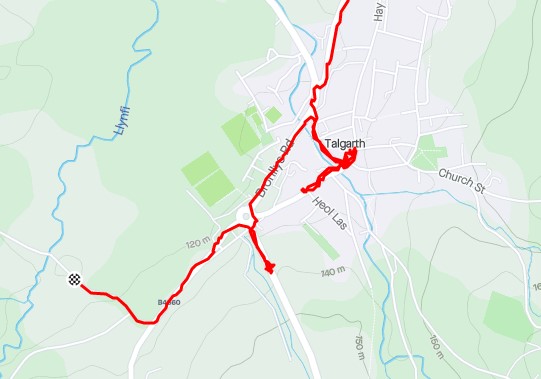
Later in the race I caught up with Andrew Nesbit who confirmed that when he passed me in the ditch I was sound asleep. He said that in his sleep deprived state, the flashing lights on my back caused him to think he had come across a car in a ditch until he got closer to me.
At 1:54am (according to Strava) I turned my watch off. It was at this stage that I decided I had finished the race. I didn’t think I could go any further. I restarted my watch at 2:51am.
I’m not sure what happened in between. Did I stop my watch then lie face down in a ditch and go to sleep. If so, the last kilometer before doing that had taken me 43 minutes. Or did I stop my watch after I woke up when I decided to drop out of the race. I don’t know.
My phone history shows that at 2:17am I rang Peter the meat wagon guy – the guy whose job it is to drive all over Wales collecting athletes when they can’t go on any further. I told him I had had enough and could he come and collect me. He told me to go back to Talgarth and wait for him, and my phone history shows that I rang him again at 2:33am to tell him I was now back in Talgarth.
While waiting for him I started to feel better and when he arrived to collect me I said that with only about 12 miles (20km) to go to the 200 mile checkpoint, I thought I should walk there and then reconsider my options at that stage. I apologised for not wanting to DNF and for dragging him out in the middle of the night, and started walking back towards my ditch again.
In total, about 3 hours had elapsed since I first arrived in Talgarth – remember that. Three hours. It becomes important later on.
The walk to checkpoint 8 at Llanfynnch turned out to be a little under 20km and took me about 3 ¾ hours. Not bad considering the mileage I had covered to date and the issues I had had in the previous few hours. Along the way I caught up with Andrew, walked with him for a while, and then continued ahead of him when he slowed down, arriving at checkpoint 8 about 20 minutes ahead of him. Other than an hour or so of rain, the walk was uneventful, and I was actually feeling pretty good.
Llanfynnch to Cardiff – 200 to 253 miles
I left the checkpoint at about 7am, 72 hours into the race, just as daylight was breaking. I needed my head torch for the first 15 minutes or so, but after that I could see my way clearly.
The next section was a 10 mile uphill climb from 200 metres above sea level to 500 metres and then, according to the guys at the checkpoint, it was all downhill to Cardiff!
The 15 mile climb went well. Andrew passed me early on and upon reaching the top Lindley Chambers and someone else were waiting with some food. I had heaps of food with me so I only took a banana , and started the ‘downhill to Cardiff’ section. I calculated that all I needed to do was walk 11 minutes and 40 seconds per kilometre for the next 64km – about 3.3 miles per hour. And with it all being downhill and a total elevation drop of 500 metres, that won’t be too difficult will it?
Five kilometres later and I was already five minutes behind schedule. This was anything but downhill all the way! Down for a bit then steep up again, then steep down. Not conducive to fast walking.
I decided to ignore my watch until we were off the steep section and nearer checkpoint 9 at Merthyr Tydfil – another place I had never been to but ‘knew’ like the back of my hand. Approaching Merthyr Tydfil we headed on to the Taff Trail which would take us all the way to Cardiff. Over and over again I ‘recognised’ the area and even ‘knew’ when we would be crossing the river or under/over the roads running alongside the trail.
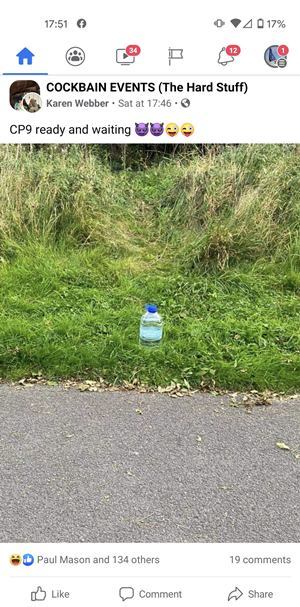
Checkpoint 9 was ‘basic’ like all the odd numbered checkpoints. In fact this one was probably the most basic – see photo – not even a chair to sit in for a short rest.
There was a McDonalds nearby but by now I had worked out that I needed to average exactly 11 minutes per kilometre for the remaining 46km (17 ½ minutes per mile for 28 ½ miles) and I was struggling to average 11:30, so no time to stop.
I asked one of the people at the checkpoint for Coke and they said they would arrange something and find me along the way somewhere – thanks to whoever that was even if you could only find Pepsi!
I tried as hard as I could but I really struggled to walk fast enough. 11 minutes per kilometre is about 17 ½ minutes per mile – about the speed that someone would casually walk to the shop. And I couldn’t hold that pace. It wasn’t physical. I put in a couple faster kilometres – in the low 9 minute range – but I couldn’t hold the pace.
Soon I found myself having imaginary conversations (arguments) between my mind and my body. My mind asked my body to go faster and my body responded by saying that we wouldn’t need to go faster if you (Mind) hadn’t gone ‘la la’ last night.
Another ‘conversation’ I remember was when my pace had managed to speed up a little and I imagined that my mind and body were now friends again and they were talking to me about how I had taken my feet for granted – “… You put your shoes and socks on 3 ½ days ago and haven’t looked at your feet since – you have taken them for granted …”
The conversations kept me entertained through to Pontypridd where I lost 28 minutes (according to Strava) walking 2km trying to find the correct route after finding the gate to the local park locked and not seeing the sign showing the after-hours diversion.
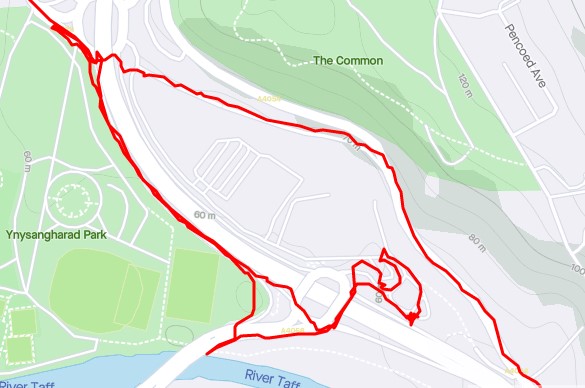
It was while I was wandering around trying to find the correct route that Gordon and Vic passed me. They had been over an hour behind me at checkpoint 9 about 12 miles earlier but they were focused on getting to the finish before 11pm – the race cut-off.
It was getting dark when I found my way back on to the correct route and I stopped for a few moments to put my head torch on. But where was my head torch? I couldn’t find it even after empty all the remaining contents of my backpack on to the ground. Fortunately, I had my spare head torch. But it wouldn’t turn on! The reason it is my spare head torch is that it isn’t 100% reliable but it has never not turned on.
I thought perhaps I had left my main head torch back at checkpoint 8. The only option was going to be to use my phone as a torch – how long would that last? And to walk as fast as I could and hopefully catch Gordon and Vic so that I could follow them with their head torches. The online tracker showed that they were only 1.2km ahead.
I put in a 9 minute kilometre. It was 8:30pm. There was about 20km to go. I calculated that I needed to walk 7 ½ minutes per kilometre to get to the finish by 11pm. Unlikely. The next kilometre was closer to 12 minutes followed by two more at 9 minutes each. There was no way I could go any faster than that and I wasn’t catching Gordon and Vic either.
And then I remembered that I had worn my head torch for the first few minutes after leaving checkpoint 8 earlier in the day. I felt the pocket of my jacket and there it was.
Suddenly the urgency to walk fast was gone. I had a head torch and I wasn’t going to get to Cardiff by 11pm, so why push it?
My pace immediately dropped and that was when the giants arrived. My mind started playing tricks on me again. Initially it was only occasionally that I would see a giant in front of me, and when I got nearer I would realise that the giant was actually just a tree.
Later on though, every tree was a giant – except for the trees that were actually huge bridges in the sky.
This went on for hours. I was tired and whenever I found a park bench or anything else I could sit on, I would stop and rest for a few moments. And when there weren’t giants and bridges, I felt like I had been here before. This time I ‘remembered’ being here on a school trip with my youngest son – who like me has never been to Wales other than to Cardiff city itself. More sleep deprived hallucinations and déjà vu.
I remember stopping and talking to two real people. On both occasions I asked them if they were real. I don’t know what they thought when asked that question – “Are you real?”.
Somewhere along the line I missed a turnoff over the river and followed what I thought was the proper route all the way through Bute Park and up to a big wooden locked gate. Thinking I was on the correct route, and with the river on my right I headed left looking for an exit from the park.
It was at this point that Karen Webber rang me. It was 12:30am and Karen and Peter (the meat wagon man) were waiting for me at the finish even although the race had officially finished 1 ½ hours ago. I explained my situation and apologised for taking so long, thanking Karen for waiting for me. I had assumed that I would finish the race alone, take a quick selfie finisher’s photo, and then walk to my hotel. It was nice to think that there would be someone at the finish to welcome me.
Karen suggested that I finish at the hotel rather than the Celtic Ring – the official race finish line – but I explained that I wanted to finish the official race even if I was late. I didn’t yet realise that I had gone off course.
As I was speaking to Karen I found an exit to the park and told Karen that “I will walk fast and see you soon”.
And then, just after hanging up on Karen I looked to my right and saw that I was walking beside a castle and thought to myself that “I don’t remember there being a castle in Adelaide”. Fortunately that was only a fleeting thought and I quickly remembered that I was in Cardiff, although I wasn’t sure how to get to the finish from where I was.
I opened Google Maps on my phone and typed in ‘Celtic Ring, Cardiff’. 1 ½ miles. 2 ½ kilometers.
The end was in sight and my pace picked up accordingly. 13 minutes, 11 minutes and then 10 minutes for the last kilometre.
I walked into the Celtic Ring and received a big hug from Karen – one of the biggest ultra-marathon fans around.
Karen took a photo for me and we walked the short distance to the hotel where Peter was waiting, having gone back to get me some warm clothes.
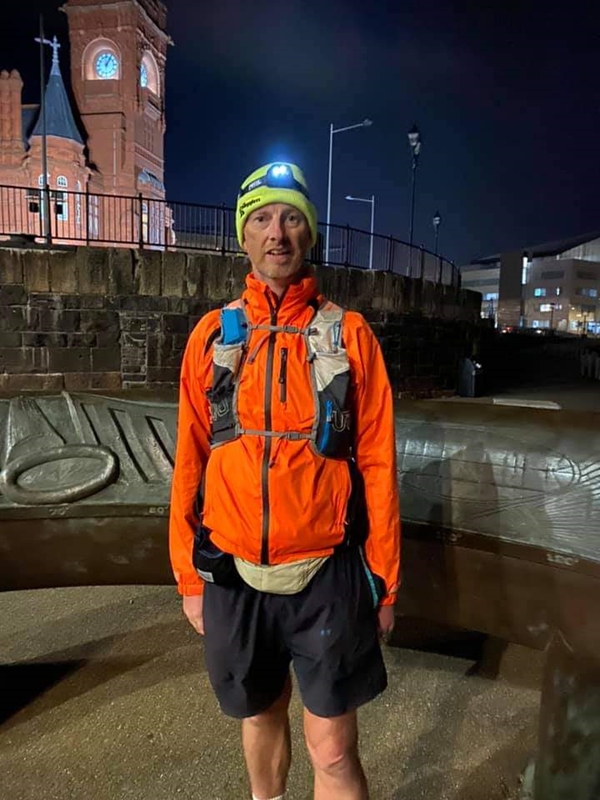
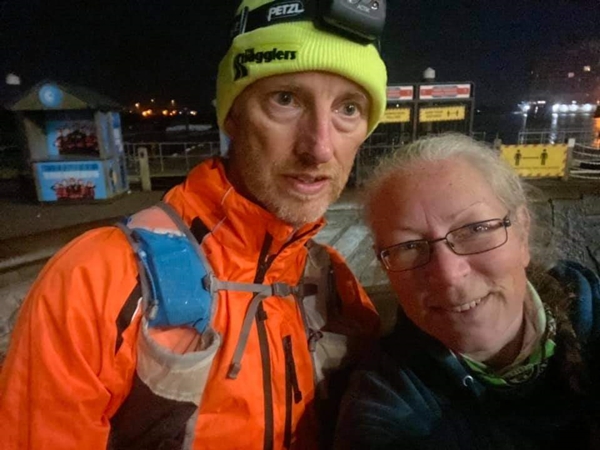
And that was my race. Holyhead to Cardiff in 90 hours and 5 minutes. 2 hours and 5 minutes too late to be an official finisher but 13th to cross the finish line out of 29 starters.
What ifs:
Could I have finished within the 88 hour cut-off? Absolutely. I lost three hours when I went ‘la la’ on Saturday night in Talgarth. If only I had simply stopped and had a 30 minute sleep.
I lost 30 minutes when I got lost in Pontypridd and 30 minutes on Friday night when I went the wrong way, although I gained about 30 minutes on Friday morning when I accidentally took a short-cut. In total I walked 420km according to my watch – an additional 13km (8 miles).

Will I try again?
NO!
My aim was to walk from Holyhead to Cardiff. I didn’t manage that in 2019. I did in 2021. It doesn’t matter to me that I took two hours longer than the race cut-off.
I have added a line across Wales to my ever-growing map of where I’ve walked, and I have other lines to add elsewhere.
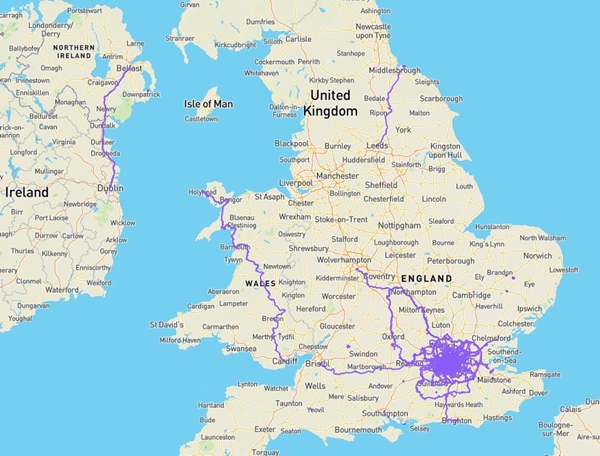
Congratulations to:
A couple people that I would like to congratulate:
- James Bassett
James finished first equal in 76 hours and 16 minutes together with Stephen Davies.
I first met James when he was a race-walker at the UK Centurion qualifying race in Bury St Edmonds in 2017. James qualified as UK Centurion 1175 in an impressive 21 hours 24 minutes that day but has since switched to running and had his best race to date at the Lon Las Ultra. James’ race report is here. - Tom Garrod
Tom was not in a very good condition when I caught him at checkpoint 3 early on Friday morning. But he bounced back and finished the race in 3rd place in 79 hours 32 minutes.
He then had a 20 hour rest before running back to the start, completing 506 miles in total in a little over nine days! - Steve Willis
I spent a reasonable amount of time with Steve on the Saturday and a little bit on the Friday as well. At one stage on the Saturday he told me he was thinking about dropping out. He didn’t, and went on to finish 9th in 85 hours 42 minutes. - Andrew Nesbit
I didn’t spend much time with Andrew. Only an hour or two in the early hours of Sunday morning. Andrew finished in 10th place in 87 hours and 11 minutes. - Gordon Hughes and Vic Owens
I didn’t spend any time with these two. I caught them some time before checkpoint two and they passed me at Pontypridd. Their finish time: 87 hours and 58 minutes!
I can’t imagine the mental pressure you two put on yourself to get to the finish before the 88 hour cut-off. Awesome! - Everyone else who started
Whether you finished or not, this is one very tough race. Congratulations on just being brave enough to start the race.
A big thank you:
Firstly to Karen and Peter for staying up to welcome me to the finish. It means a lot to me. Thanks.
Thanks also to Mark Cockbain for organising a great race, and to all the volunteers that helped us get from Holyhead to Cardiff.
Someone messaged me a few days after the race saying that Not all DNF’s are equal. I don’t know whether he was comparing his DNF to mine (Officially I am listed in the race results as a DNF because I didn’t finish within the 88 hours), or my 2019 DNF to my 2021 DNF. But thanks.
And thanks also to all the people who watched our dots moving across Wales of the race tracking website, sent us messages of support, commented on the Cockbain Events facebook page, etc. Knowing that we had your support helped when times were tough.
What’s Next?
For me it is the end of the year. I have struggled with niggly injuries since January and I’m now taking two months of complete rest to try and recover. I am seeing an Osteopath (thanks to medical insurance) and have joined a gym to work on my core strength and swim every second day.
At this stage my next race won’t be until May 2022 when I intend to smash my six day PB and hopefully become one of just six or seven race walkers to have walked 700km in an official six day walking race.
Written by Tremayne Dill Cowdry - https://dill-runs.blogspot.com/
As UTMB drew closer the uncertainty was doing my head in. Would we be able to travel? Will the race be able to enter other countries? Will it even go ahead? Will it get cancelled and I lose my hard earnt place for ever. A pandemic makes racing tricky, it makes travelling to a race even trickier. As soon as UTMB stepped up and offered deferrals to 2022 I was on it. Deferred. That left a gaping hole in my race calendar. Ultra Trail Snowdonia sat just 2 weeks after UTMB, It is an Ultra Trail World Tour Event and in one of my favourite places. Since my Bob I've been considering a Paddy round but was still yet to recce as my three previous attempts to recce had been scuppered by the weather. So what better opportunity, enter the UTS165, get to experience some of the Paddy terrain and take part in a badass race. I was in.
As we crossed the A5 from the campsite towards the start my mind wandered, thinking about how I'd been told by a couple of friends how hard the 50 mile race had been a few years previous. Both had expressed to me what a complete hellish experience it had been. I mean how hard could it be? I've done hard races, what would make this different? I was about to find out. It had rained solid for 5 or so hours prior to the 11am start, luckily it had stopped for now and with little fuss or excitement we were given the GO and sent on our way.
The start is right at the base of Moel Siabod and after a couple of hundred metres of jogging we were hiking. It was a steady up and I chatted briefly with Drew Sheffield (a previous winner of the race) and Mark Collinson who I bump into at all the major UK events. Both previous finishers and both gave me glimpses of what lay ahead. After an hour of steady climbing we summited but instead of following the natural path we veered off and started a long and knarly descent. We skipped over rocks, slid on our arses and tried desperately not to fall over. The pace was hard, hard for a first descent, the views were stunning. I stopped to take a couple of pics. This was fun. After the first steep section things levelled out slightly and we entered some forest and followed an undulating path at last feeling like I could run a bit. I looked at my watch and we were just 5 miles in which had taken about 2 hours. I won't lie I was feeling it. We rolled into cp1 for a well earned drink. I needed my coke fix.
Leaving the Cp I joined the road which led into a forest track it was steady up hill and I hiked the next mile or so until the track went straight up into the thick woods. The area beyond had been heavily forested and there was mud a plenty. It climbed steeply to the top before the steady run down through the amazing derelict quarries. The humidity was very high so far, I was really sweating one out. My water was running out fast and I was feeling uncomfortable. We soon reached Ffestiniog and civilisation. Dan Milton was there and it was good to chat and rest for a bit. I had been on the go for about 3 and half hours and a half marathon in. Dan said "see you at 100k", it actually felt a million miles away.
I was still so hot, my internal thermostat was stuck on full and I couldn't get cool. I walked
with my coke and half a cheese sandwich just to try and regulate myself. I was carrying a lot of calories for this race. I'd figured I'd potentially be out for 40 hours max so I carried 20 items of 100 calories for the first 50 miles then I'd pick up another 20 at half way to get me through. I had a main stay of gels but also had a few bars, my plan was to have 100 cals every hour then top up with a further 200 or so every checkpoint.
I spent much of the next section leap frogging with other runners, a long steady climb over grassy non descript terrain, lots of bog, tussocks and disused quarrying sites. We reached a point and the guy I was alongside said we had about a mile descent that was really runnable. I just opened up and sprinted down just to keep my legs turning over properly. I grabbed some coke at the next cp and moved on up the very tough climb of Cnicht. It went on for ages and was incredibly misty at the top. We were now about 19 miles in and I was pretty tired. 5 hours had passed. Now Cnicht was done I thought that I'd actually be able to do some running. How wrong could I have been. I soon found myself alone for the first time. I followed the gps track closely. The group I had walked behind up the mountain had surged ahead. I desperately tried to get my heart rate down before trotting on. The next few miles were ridiculous. Every step was into a potential bog. Massive holes in the bog were scattered everywhere where previous runners had pulled themselves out. I was so careful knowing I could get swallowed up by the muddy mess at anytime. I reached a sharp left turn on the grassy trail. Easily missed as the markings were a bit far apart. I took the turn but the group from earlier had not and soon came running up behind me again. As we started to descend runners were appearing from all sides. All had obviously missed the turn in the mist. It was a slog even on the down basically just bog hopping. After about 2 hours of hard bog running and just 10k covered I reached a road. I was in shock, that section had blown my mind. I passed a guy on the road as I trotted along he had obviously gone into the bog upto his chest and looked really pissed off. I reached CP4 and started to refill my long depleted bottles. I needed water badly. The bog guy from the road promptly stripped his pack off and declared he was out. I couldn't blame him. A marathon covered in 7 hours. The aidstation was in the middle of nowhere like most of the others. Being that there was no death bus or phone signal for that matter it was just best to carry on because there was no way out. The race guide had given a phone number for a random taxi firm if you dropped. Not sure how that would have worked out?
I worked through the race in my head. 7 hours for the first quarter then maybe 8, 9 and 10 for the subsequent 3 quarters would have me back under 40 hours, eating pot noodles and drinking tea. Easy. I was having a second wind as I marched up the stepping stones towards Pen-y-pass. A left turn and a nice jog along the sedate miners track. The miners track turns right but of course we turned left up the massive rocky climb. The light was fading when started on the ridge of Y Lliwedd. It's high, rocky and exposed. The mist had dropped, the rock was wet and it was maximum concentration. There were other runners up there and for the first time I was feeling a chill. I had seen Mike and Alice Sheldon earlier in the race, they were looking incredibly strong and had shot off early, I caught up with them on the ridge and we crossed the ridge together. Eventually I had to stop, layer up and dig out my head torch. As I scrambled across to the end of the ridge I was supposed to pick up the Watkin path and to my left Mike and Alice were climbing down what seemed the wrong route. I carried on forward following the random markers in the thick mist, drizzle and darkness. Eventually I found the path but none of the previous 50 mtrs of rock climbing had felt right or easy. The others that had climbed down were long gone but I was now on a definite path which after a mile or so got very runnable and by the bottom I was running full pelt and relieved to be able to open up a bit again. I ran all the way in the darkness to CP5.
Walking along the road with my now standard plain cheese sandwich and third cup of coke I contemplated what might be ahead. I felt like I had run a hard race already yet we were only 35 miles in. What more could this race throw at us. I had a really bad back ache at this point which was coming from a long standing work injury that I've hoped and prayed I can keep away from my running. Only time will tell on this. The next 10k was fairly easy, maybe only a 1000ft of climb but some quite runnable bits and a nice trail along a river. This took us to Cp 6 at Beddgelert. From memory Beddgelert cp was inside. I wandered about filled with water, drunk coke and just headed off. Not a proper stop at all. As I left an aidstation member said "quick stop, impressive" as I wandered off I couldn't fathom what they had meant.
It was a steady incline out of the CP and before long there was a sign for Moel Hebog.
The climb up Hebog killed me. It was steep and went on forever. As I reached the top the weather was shocking. Steady rain, mist and a cold breeze. I was tired too. Visability was shit and it was about 2am. Chin up though. The route went up and down two further peaks. The wet rock was really pissing me off now. This had really got hard. I dropped down again to find a couple of marshals in the middle of nowhere. I think they had been placed to provide emergency water although I didn't recall any water being there. I climbed back up a slope again only to join a really dodgy rocky ridge line. I was tired and and a tad confused. I followed the markings but the route was so unclear I couldn't believe this was the way. A couple of guys had joined me but we were having communication issues due to all of us having different first languages. We reached a point and could actually see no way through. We climbed across massive wet rocks all of us falling several times. This was getting silly. I was aware in the mist we were very high, very exposed and there was large drops either side. A massive boulder blocked our way and to the side of it was a flat slab maybe a metre by a metre. Tadeusz got on it first and slid off the other side, then Chean did the same. Before I knew it and against my better judgment I was on the slab. It then occurred to me it was a sheer drop directly to my side, I was on a slippy slab with a drop off one side. What the hell was I doing? Why wasn't this bit marked? Where were the guides to get us beyond this point? The guys sensed we had put ourselves at risk and help me forward. I must say I was pretty pissed off at this point. 3am in the rain and mist, not a clue where we are going and in potential danger. I couldn't help thinking about the poor guy who had lost his life at the TDS not three weeks before. We threaded our way through the rest of the rocks before reaching some solid ground. Just before the summit of Y Garn we turned off and descended on a normal ish path. We eventually reached the halfway point around 5am. I was determined to pull out, I'd had enough. On reaching the Cp I grabbed my drop bag and went and sat inside. I needed a rest and to get my head together. 
I sat and emptied my drop bag across the floor. I'd had my waterproof socks on for 50 miles and 16 hours by now so they needed to come off. My feet were wet but having waterproof socks on seems to help keep my chronic foot maceration at bay. I immediately wrapped my feet in a towel, ate my pasty and drank a massive can of Monster. Was I actually going to drop I asked myself?. No. Middle of nowhere, no cabs, already been out for 16 hours and although still bitching in my head about the Nantlle ridge I needed to finish this. I sat there and something clicked in my head. If I continued from this aidstation I would finish because there was no way I was ever coming back. I powdered my feet, got changed, restocked my pack, packed my dropbag, grabbed a sarnie and wandered off up the trail.
From Rhyd ddu I got straight on the Rhyd ddu path which leads to the summit of Snowdon. Its a long hike that I managed to power up passing a few people but mainly I was alone. By the summit I was in the mist again but daylight had broken and I had a new found determination. The summit was busy already to my disbelief. Yes it was Saturday but please. Dark, misty and queuing for the summit. I descended on the Ranger path for a while before veering off to the next CP. From what we had experienced so far this climb and descent of Snowdon had been rather sedate. The checkpoint staff informed us that some signage had been messed with so to be careful. 55 miles in and I'd had enough of hills, I looked ahead and saw a massive hill but thought surely we must skirt around this one. I managed to get my self a little lost in the small forest, for some reason I just ignored the signage and did my own thing. I popped out the other side of the woodland not too far off track but I did have to climb a barbed wire fence, not great when your legs are like jelly. As I re-joined the path I could see ahead the orange markers disappearing up the mountain I had just seen and into the mist. It was a hard, grassy climb. At the summit I could just see another mountain. Up again! The descents now were killing my big toes. The nail was pushing hard into the end of the shoe, the steeper the descent the more it hurt. I had a quick system check and my back hurt, knees were sore, calves sore, toes killing me, maceration pain coming on and shoulder pain from using the poles. Ok I was a wreck but my quads were holding up and my energy levels were not too bad. CP 9 was 100k where I saw Dan again. We had a good chat as I ate another cheese sandwich and lots of coke. It was quite a lift to see a friend and I left happy enough. Just 40mile to go now and probably near or around the 24 hr mark. I knew the next 40 would take a while but the first night was behind me and there was no way I was stopping now.
I hiked up through the village of Waunfawr, it was nice to see some human life. Much of this race is in the middle of nowhere so it felt comforting to be around people. The hike up the road lead to a track before a turn right and another slog up. This time Moel Eillio, Foel Gron and Foel Goch. You get the picture. Leave checkpoint, climb massive mountain, descend to Checkpoint and repeat. On this descent I could recognise we were heading back down towards LLanberis. This chirped me up a bit knowing the climb back up Snowdon wouldn't be too bad. Around this time I met Richard Thompson for the first time, we passed each other a few times, exchanged a few words but were both pretty focused on our own race.
I left the LLanberis Checkpoint very quickly leaving Richard behind. I soon joined the LLanberis path aka Snowdon High St. It was busy! I have honestly never seen so many people walking off a mountain. At points the path is about 3 metres wide and I couldn't pick a route through. I had my sticks out for the long slow walk up. It was nicely broken up chatting with the walkers coming back down. I was extremely tired and occasionally getting flicking eyelids but in the grand scheme of things this was easy going. Richard passed me a marched ahead. I was going well and didn't feel the need to chase him. After what seemed like an age I was near the top and back in the mist. The mist and masses of people were disorientating me. I couldn't work out in my head where the start of the Pyg track back down was. I have been up there at least 50 times but I felt completely lost. I found a marshal and just stood staring at his face. He looked and said "you ok mate". I'm not sure I even answered such was my mental state. This race was taking everything from me. It was obvious this was the turn and I started heading down. The amount of people was doing my head in, I couldn't get past. Luckily a few 100k runners came behind a were waiting for no-one. They literally barged through. I jumped in behind them and followed through until the hoards dispersed a bit. The Pyg track is a fairly simple descent but my legs were like stilts and the wet rock was still quite hazardous. Not only was this race physically demanding but the mental demands are massive. The concentration it takes coming down rocky terrain is high. I was catching Richard slowly. We reached the carpark after an age. Straight into the Cp. 77 miles done and roughly 3 quarters done. It must have been about 3pm so I'd been on the go for 28hrs. A few rough calculations and I was fairly sure I was going to spend another full night out. What could I do? Just crack on. Only a marathon to go.
This next section was going to be tough. Lots of hard rocky terrain. Straight up to the summit of Glydr Fawr. I left the cp and soon started losing the markers. They were sporadic and didn't match the GPX file at all. I could see high up on the hill side a few runners so just picked a line through and steadily worked my way up. Tadeusz who I'd crossed the Nantlle ridge with joined me again. He was really struggling with the markers and couldn't see anyone on the hillside. I told him to follow me, he wasn't sure but did. It was fairly hard going but we joined the really steep bit where I'd seen people earlier and the markers re appeared. I climbed the steep hill side pressing on into the mist toward the summit. I met with Mike and Alice Sheldon again and Richard had joined us too. Alice was struggling on the climbs and I was slow on the descents. So we were all roughly the same speed. The rocky landscape was doing my head in and I was hallucinating, seeing lots of faces on rocks. We were scrambling, climbing, shuffling and stumbling all the way to Y Garn. Richard and I crept ahead again. Light was fading and the descent was steep and super technical. It just went on forever. Maximum concentration and maximum pain in my feet. Maceration was taking hold, as were blisters, pain in my big toes and just soreness from being on my feet. Mike and Alice overtook us and got quite a way ahead. We were heading down to the Ogwen valley, great I thought just run across the lakeside to the checkpoint. No chance! We had to climb back up the side of Tryfan round the back and back down to the checkpoint. This was some knarly shit. Actual rock climbs, dodgy marking and the fact I had zero idea what was even going on. Night time had come and torches were on. We had caught Mike and Alice once again. There are times in distance running when you just need to tuck in behind someone and shadow them and concentrate on moving forward. This was mine. I didn't know where we were, what we were doing or why. Every so often I kept twigging we were in a race but most of the time I believed we were on a recce or my usual odd thoughts of walking to work. This with heavy hallucinations was hard work. The four of us were in the same boat though and between we had all the attributes to stay on course and keep moving forward. Reaching CP12 was a massive relief. I was in shock. Everything was hurting. Mike said look why don't we stick together now, we are all tired and it will be safer and quicker to work as a foursome. We all agreed. I completely lost my bearings at this point and argued we were heading in the wrong direction but it is always hard getting your bearings leaving an aidstation. I can look back at the map now and its all so obvious.
There were no markings leading up Pen-Yr-Ole Wen and we relied on my Etrex. Nothing seemed right but my head was a little straighter so I was able to pick a path through. It was a hard climb and it was clear I was moving very well on the ups but no point steaming off as we had agreed to work together so every so often I'd wait for the others. From the top we were to spend the next few miles very high up in the Carnedds. Scrambling over rocks with a few real rock climbing sections. It seemed surreal, like it was happening and not all at the same time. Mike started rambling about not knowing what was going on. I chuckled, I knew that feeling. We went on and on through the abyss of rock and mist. We changed direction off of Carnedd Llewelyn and the rocks started to disperse slightly. Mind you the lichen covered rocks made for some mental hallucinations. I was seeing people, animals, vans, cars as vivid as real life. We reached Pen yr Helgi Du and It was an actual climb. It was a little tricky especially with 90 miles in your legs. We climbed straight up the rock face which I must admit I kind of enjoyed. By this time we had amassed a few of us as some of the 100k runners had tagged on. We must have looked like we knew where we were going! Over the climb it changed to grass and was the beginning of a massive descent. I was trashed now but Mike insisted we should run. It was either that or a death march so we trotted down the grassy descent. We were actually in the middle of no where. Every so often I would switch my light off. No light not even light pollution, no sound. So quiet it makes your ears hurt as they strain to pick up any sound. A very strange feeling. I could see a little light in the distance that never got closer but eventually after a very long time I worked out this was the final aid station we jogged down the hill and into the Checkpoint. My feet were now shot, the pain was unbearable. So much so I took some paracetamol just to take the edge off. No use removing my shoes as there was nothing I could do. It was about 3 am with about 6 miles to go. My internal thermostat was now completely knackered, I was still sweating although there was a chill. It was a horrible feeling. I just wanted it to end now.
The last leg was under way and no major climbs on this one. Immediately after leaving the checkpoint I started coughing. I had a tickly throat and it made me gag to cough. The urge to cough was too strong and I started again promptly followed by the contents of my stomach. All of it!. Running was near impossible now. I was tired and hurting. Alice was in pain too. Richard could walk at the same speed as my run and Mike was pushing us all forward. We joined a lakeside path but it was hard going as it was so rough. Power hiking was the best option. Daylight hit us at this point and I was able to remove my headtorch. My main concern now turned to the sleep demons. I could not keep my eyes open and was having micro sleeps every few seconds. I kept wandering into bushes and stumbling off the path. I really hate that as I had no control. We left the lake and entered the forest. This was heavy mud and one point Alice lost her whole leg into a bog. I tried to help her but was just making things worse so let her scramble out herself. As we left the forest I thought we were done and said that's it we must be here. I was soon put in my place by the others who knew we still had a 3 mile walk over more hills until we eventually reached the A5 again. We agreed to cross the line together and it was a great feeling running along the road at a walking pace knowing it was over. As we approached the line they held a finish line tape up. Alice was going to win the ladies race so we pushed her forward to take the tape a few seconds before we flopped over the line.
I was in shock. The race had brutalised me. Everything hurt and my brain was not working. The relief was massive. I'm so glad I done it as I never want to attempt it again. It was 45 hours 9 minutes and 57 seconds of hard slog. That is easily the hardest 100 mile race I have taken part in. Time is irrelevant, its simply did you finish or not. I think if it had been dry before and during the race it would certainly be a lot easier but as it was it was as described. Savage beyond reason.
Go on put an entry in I dare you!
This was going to be my unofficial Paddy taster. I'd guess this is much harder than a Paddy and I won't be attempting any Paddy attempt or recce in anything but dry, sunny conditions. So I won't say I won't have a go but I'm a little less inclined.
Just one final thing. When I researched this race I was constantly trying to gain a comparison to UTMB. Which is harder? Without a doubt UTS is harder than UTMB.







